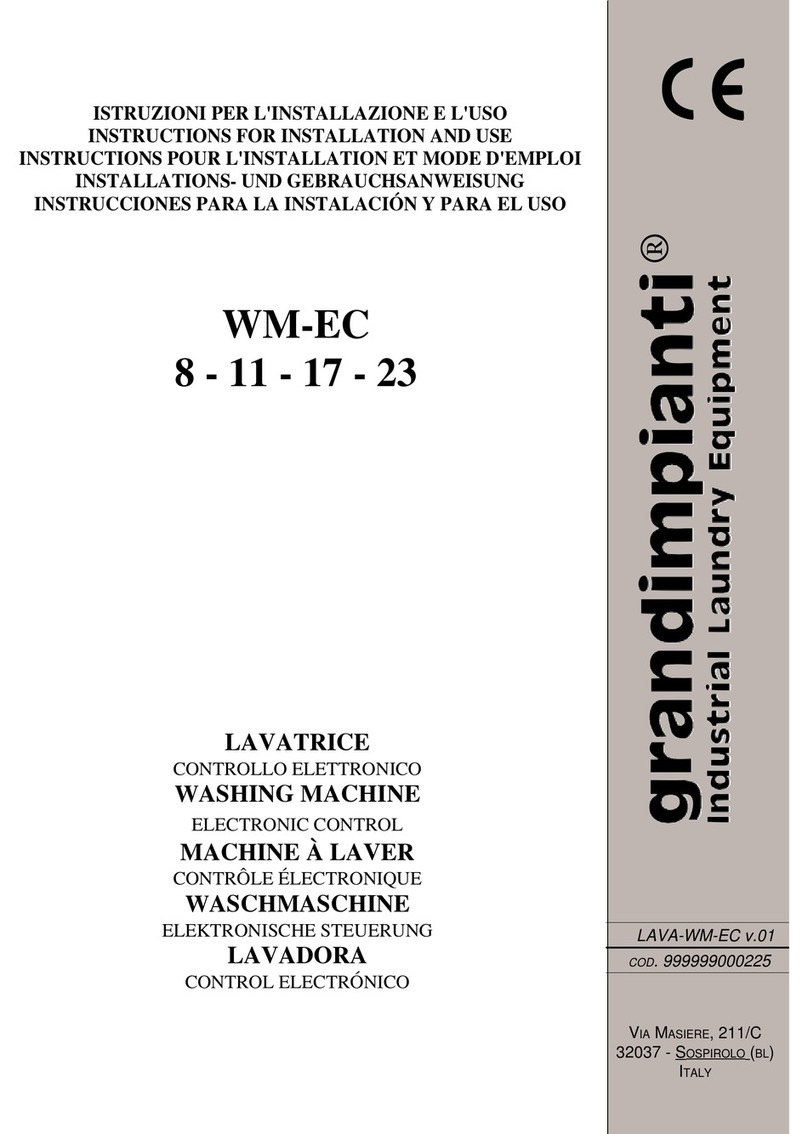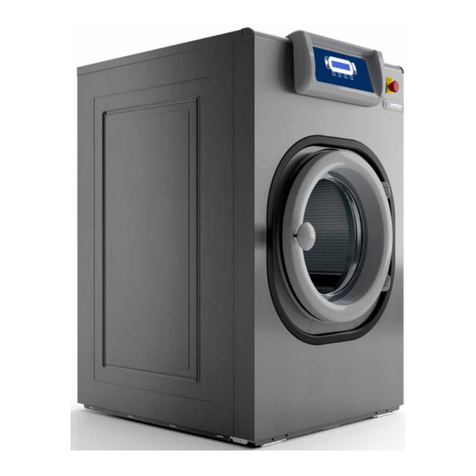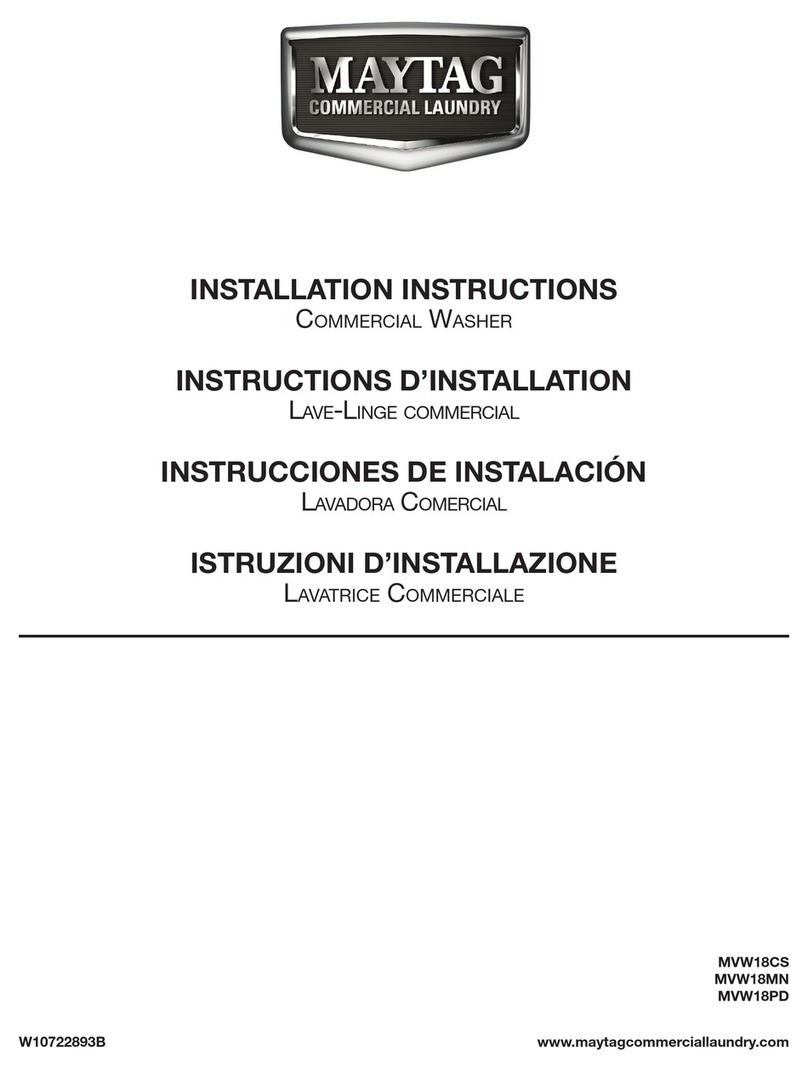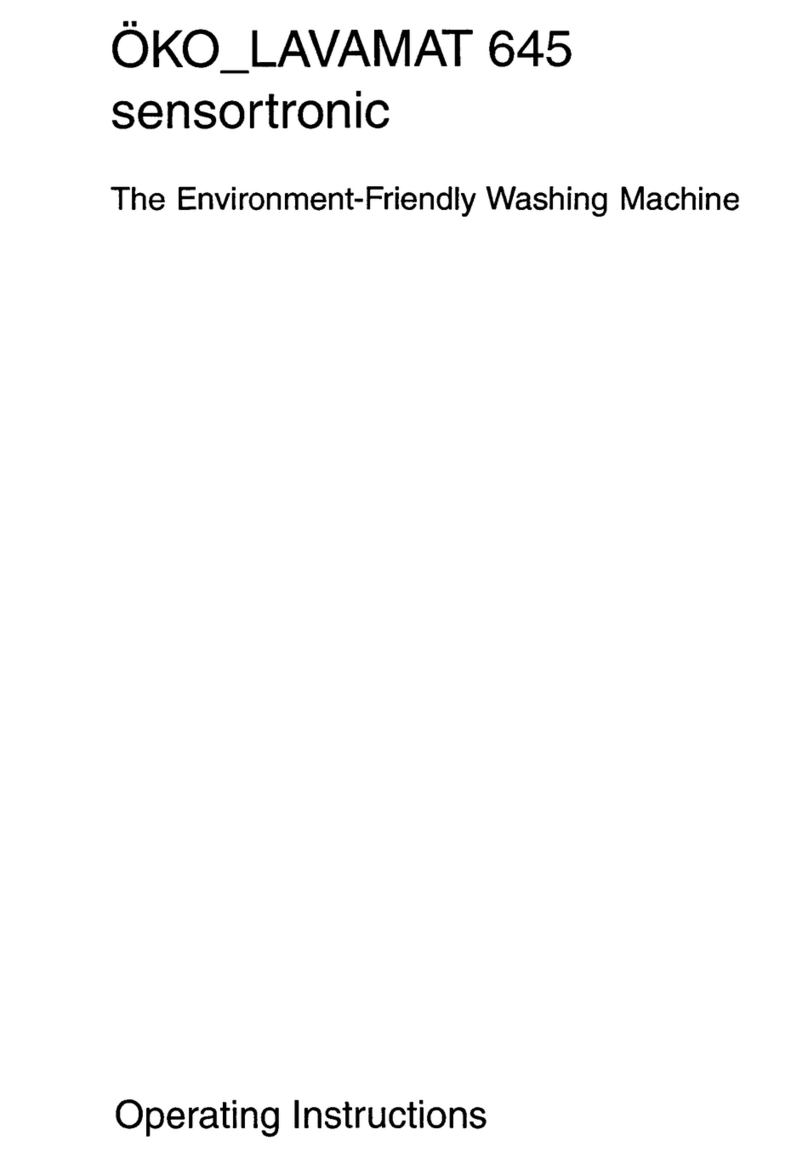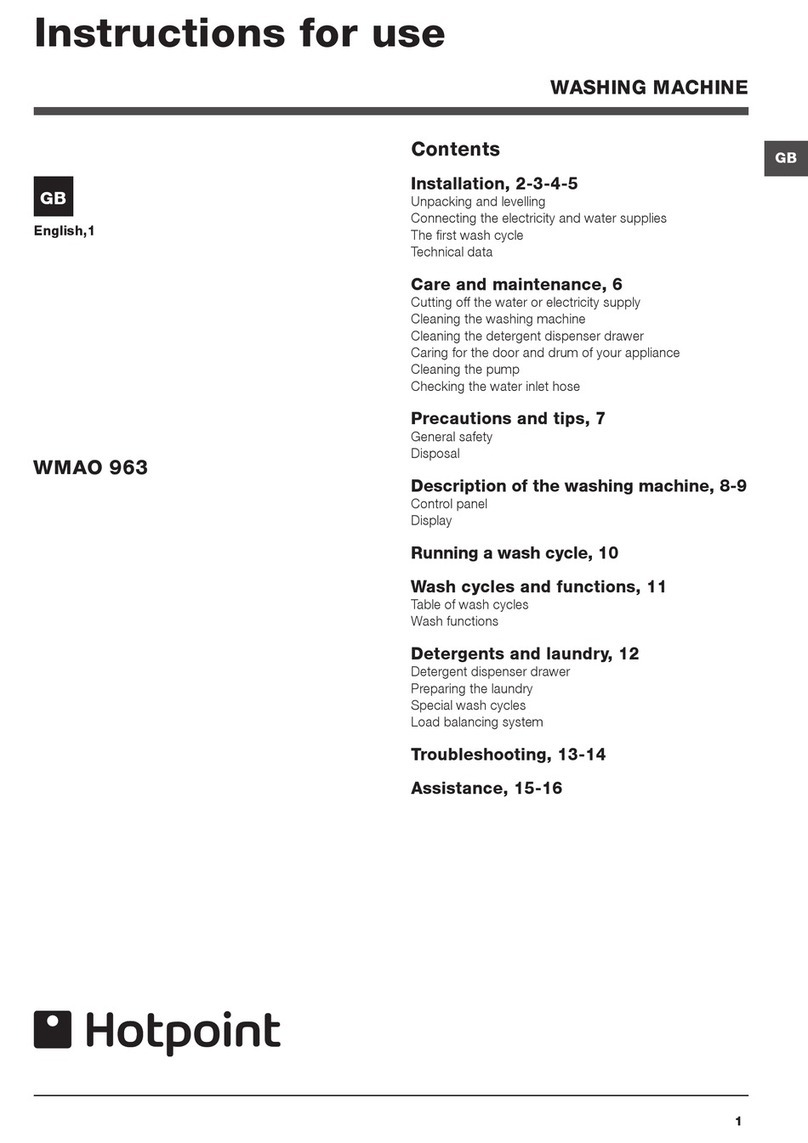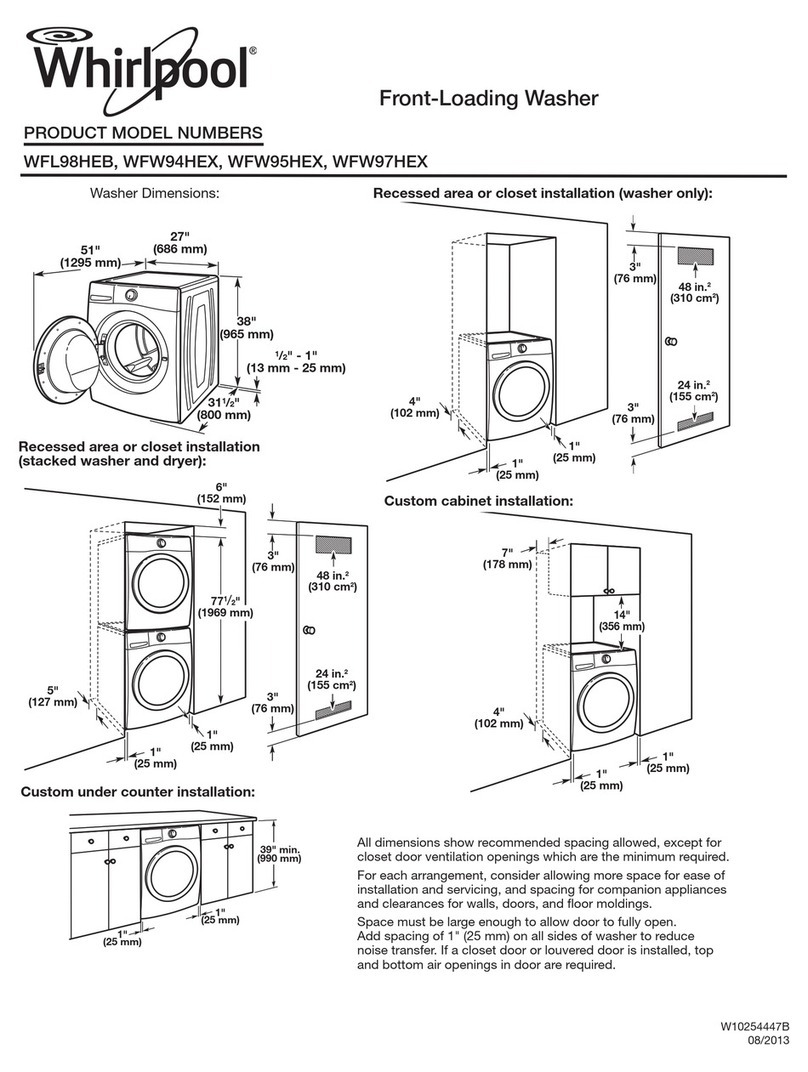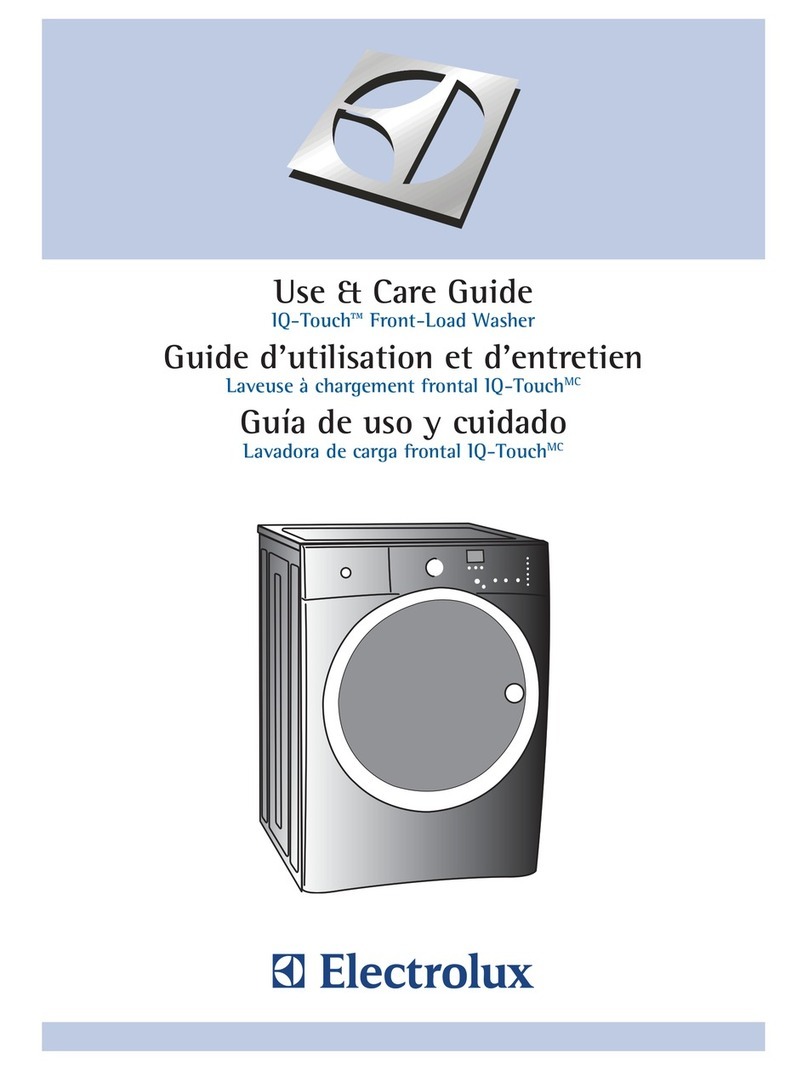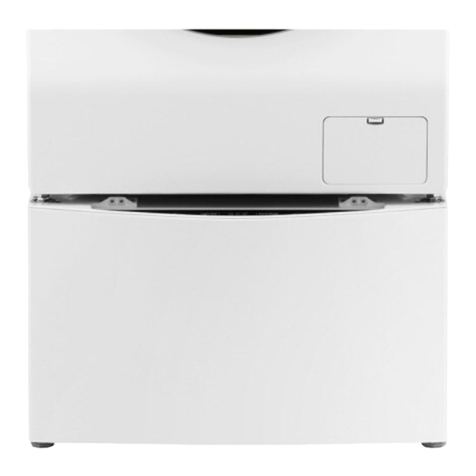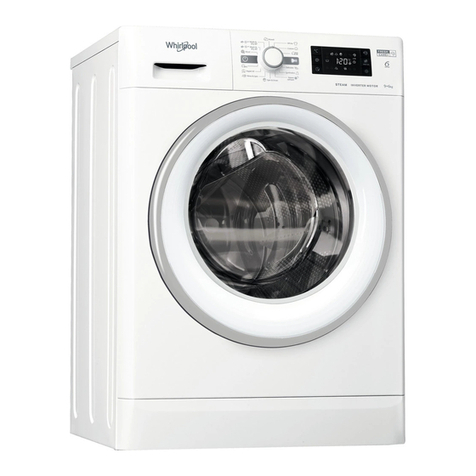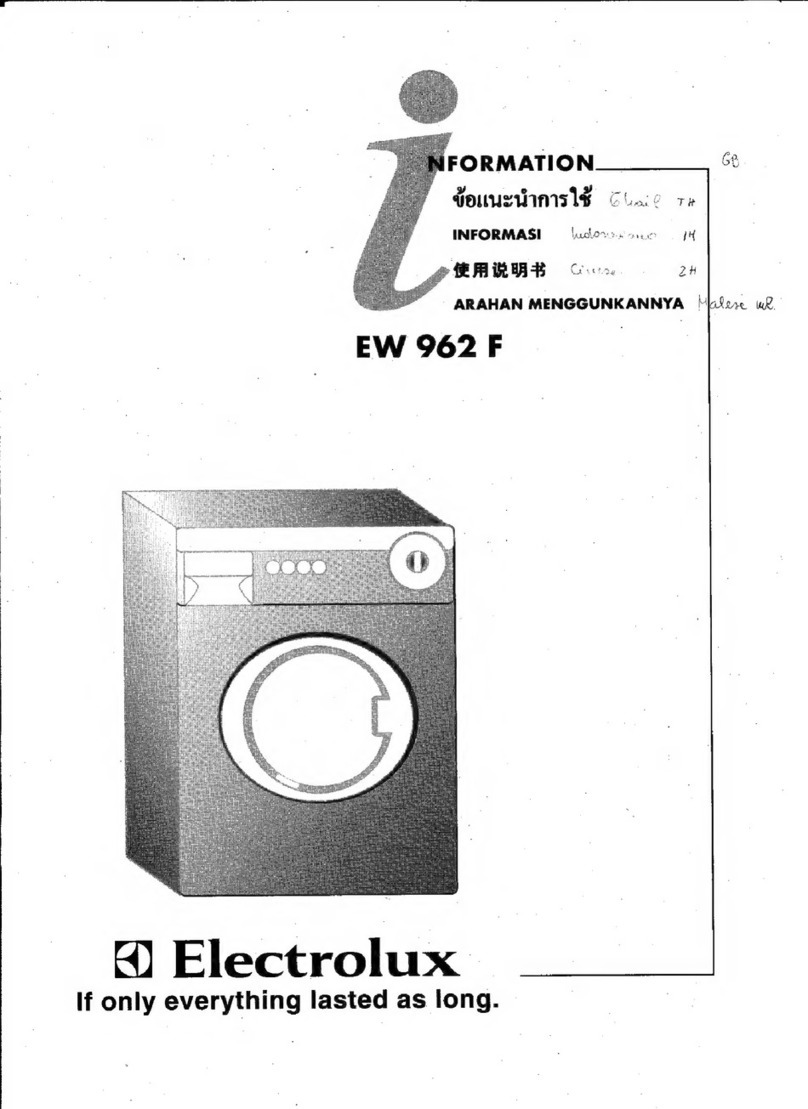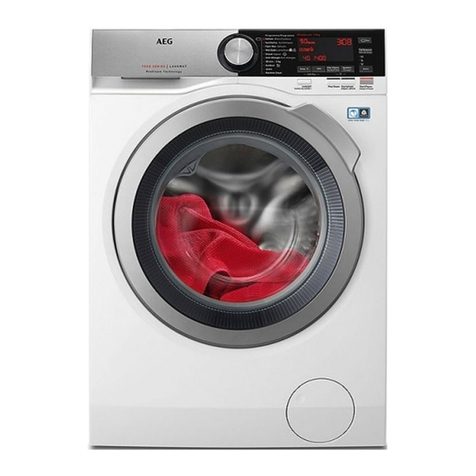grandimpianti WFC 5 User manual

ZONA INDUSTRIALE
32037 - SOSPIROLO (BL)
ITALY
ISTRUZIONI PER L'INSTALLAZIONE E L'USO
INSTRUCTIONS FOR INSTALLATION AND USE
INSTRUCTIONS POUR L'INSTALLATION ET MODE D'EMPLOI
INSTALLATIONS- UND GEBRAUCHSANWEISUNG
INSTRUCCIONES PARA LA INSTALACIÓN Y PARA EL USO
WFC 5
LAVATRICE
PROGRAMMATORE A CAMME
WASHING MACHINE
CAM CONTROL MODELS
MACHINE À LAVER
PROGRAMMEUR À CAMMES
WASCHMASCHINE
PROGRAMMSCHALTER MIT NOCKEN
LAVADORA
PROGRAMADOR A LEVAS


1
ISTRUZIONI PER L'INSTALLAZIONE E L'USO
INSTRUCTIONS FOR INSTALLATION AND USE
INSTRUCTIONS POUR L'INSTALLATION ET MODE D'EMPLOI
INSTALLATIONS- UND GEBRAUCHSANWEISUNG
INSTRUCCIONES PARA LA INSTALACION Y PARA EL USO
GB
I F
INDICE Pagina
1) Garanzia .....................................................2
2) Introduzione ...............................................2
3) Prescrizioni, divieti, ed usi diversi
della macchina............................................2
ISTRUZIONI PER L’INSTALLATORE
4) Indicazioni per il trasporto, disimballaggio,
movimentazione, immagazzinamento ........2
5) Indicazioni per la messa in servizio
della macchina............................................3
ISTRUZIONI PER L’OPERATORE
6) Indicazioni relative alla macchina ..............4
7) Indicazioni relative all’uso della macchina
e alla manutenzione ordinaria .....................4
ISTRUZIONI PER MANUTENTORE E
RIPARATORE
8) Indicazioni per la manutenzione straordi-
naria ed approvvigionamento pezzi di
ricambio .....................................................5
9) Indicazioni per la messa fuori servizio,
smantellamento, ed eliminazione della
macchina ....................................................6
Caratteristiche tecniche .....................................
Legenda componenti elettrici ............................
Schema elettrico circuito ausiliario di
principio ............................................................
Schema elettrico circuito di potenza ..................
Esplosi...............................................................
Lista pezzi di ricambio ......................................
INDEX Page
1) Guarantee ...................................................7
2) Introduction ................................................7
3) Instructions, restrictions and other
uses of the appliance ..................................7
INSTRUCTIONS FOR THE INSTALLER
4) Tips about shipping, unpacking,
moving and storing the machine.................7
5) Tips about getting the appliance started......8
INSTRUCTIONS FOR THE USER
6) Information about the washing machine .....8
7) Information regarding the use and ordi-
nary maintenance of the appliance .............8
INSTRUCTIONS FOR MAINTENANCE AND
REPAIR WORKERS
8) Tips about maintenance and ordering
spare parts ................................................10
9) Suggestions for putting the washing machine
out of service, dismantling and disposing
of it ...........................................................10
Technical data ...................................................
List of electrical components.............................
Main wiring diagram of auxiliary circuit ...........
Wiring diagram of power circuit .......................
Exploded drawings ............................................
List of spare parts ..............................................
INDEX Page
1) Garantie....................................................11
2) Introduction ..............................................11
3) Prescriptions, interdictions, utilisations
diverses de l'appareil ................................11
INSTRUCTIONS POUR L'INSTALLATEUR
4) Indications p. transport, déballage, mise
en place, stockage de l'appareil.................11
5) Indications pour la connexion de
l'appareil ...................................................12
INSTRUCTIONS POUR L'UTILISATEUR
6) Informations sur l'appareil ........................13
7) Indications pour l'utilisation et l'entre-
tien de l'appareil .......................................14
INSTRUCTIONS POUR LE PERSONNEL
RESPONSABLE DE L'ENTRETIEN ET
RÉPARATIONS
8) Indications pour l'entretien extraordi-
naire et l'acquisition pièces détachées .......14
9) Indications pour mise hors service, dé-
montage et l'élimination de l'appareil .......15
Données techniques .......................................__
Légende des composants électriques .............__
Schéma él. de principe circuit auxiliaire ........__
Schéma électrique circuit de puissance..........__
Vues explosées ..............................................__
Liste des pièces détachées ......................._____
E
INDICE Página
1) Garantía....................................................21
2) Introducción .............................................21
3) Prescripciones, prohibiciones y otros
usos de la máquina ...................................21
INSTRUCCIONES PARA INSTALADORES
4) Indicaciones sobre el transporte, el des-
embalaje, el desplazamiento y el depósito
de la máquina ...........................................21
5) Indicaciones para la puesta en servicio .....22
INSTRUCCIONES PARA UTILIZADORES
6) Indicaciones sobre la máquina...................23
7) Indicaciones sobre empleo de la máquina
y el mantenimiento ordinario....................23
INSTRUCCIONESPARALOSENCARGADOS
DEL MANTENIMIENTO Y REPARACIONES
8) Indicaciones para el mantenimiento
extraordinario y el abastecimiento de
repuestos ..................................................25
9) Indicaciones para la puesta fuera de ser-
vicio, el desmantelamiento y la elimina-
ción de la máquina....................................25
Datos técnicos ...................................................
Leyenda componentes técnicos .........................
Esquema el. circuito auxiliar de principio..........
Esquema eléctrico del circuito de potencia ........
Dibujos de repuestos .........................................
Lista de repuestos ..............................................
INHALTSVERZEICHNIS Seite
1) Garantie ...................................................16
2) Einführung ...............................................16
3) Vorschriften, Verbote, verschiedene Hin-
weise für den Gebrauch des Gerätes........16
ANWEISUNGENFÜRDENINSTALLATEUR
4) Hinweise für Transport, Auspacken, Auf-
stellen und Lagern des Gerätes ................16
5) Hinweise für Inbetriebnahme ..................17
ANWEISUNGEN FÜR DEN BENUTZER
6) Hinweise zum Gerät ................................18
7) Hinweise für Gebrauch und Wartung
des Gerätes...............................................18
ANWEISUNGEN FÜR DEN WARTUNGS-
UND TECHNISCHEN KUNDENDIENST
8) Hinweise für die Instandhaltung des Ge-
rätes und Bestellung von Ersatzteilen......19
9) Hinweise für Außerbetriebnahme, Ab-
bau und Entsorgung des Gerätes .............20
Technische Daten .............................................
Liste der elektrischen Einbauteile.....................
Schaltplan des Hilfsstromkreislaufs .................
Schaltplan des Hauptstromkreislaufs................
Explosionszeichnungen ....................................
Ersatzteileliste...................................................
D

2
ISTRUZIONI PER L'INSTALLAZIONE E L'USO
I
PREMESSA
Desideriamo ringraziarvi della preferenza
accordataci con l’acquisto della nostra
macchina. Siamo certi che otterrete le
migliorisoddisfazioniegaranzieseseguirete
attentamente le indicazioni contenute nel
presente manuale.
Vi informiamo inoltre che in qualsiasi caso
il testo di riferimento per eventuali
contestazioni o osservazioni rimane quello
inlinguaoriginaledelcostruttore,ovverosia
l’Italiano
1. GARANZIA
-Lagaranziahaladuratadimesidodici(12)
a partire dalla data di acquisto dell’apparec-
chiatura o parte integrante della stessa.
-Lagaranziaconsistenellasostituzionedel-
lepartieventualmentedifettoseperaccertate
cause di fabbricazione e viene applicata
direttamente dal vostro fornitore.
-Lamanod’operaèsempreacaricodell’ac-
quirente, come pure le spese di trasporto,
imballo e rischi di trasporto.
- La garanzia è subordinata alla restituzione
dei pezzi avariati in PORTO FRANCO ed
alla contemporanea comunicazione dei dati
riguardanti il modello, il numero di matri-
cola ed il difetto della macchina sulla quale
il particolare era montato.
- La garanzia non si applica alle apparec-
chiature che siano state danneggiate per
negligenza,erratocollegamento,installoin-
adatto, mancata osservanza delle istruzioni
dimontaggiooimpiegoecomunquealterate
dapersonalenonautorizzato.Nonsi applica
inoltre qualora il numero di matricola sia
stato alterato, cancellato o asportato.
-Nonsiapplicalagaranziasulseguentema-
teriale:
parti soggette a normale usura quali cin-
ghie, membrane delle elettrovalvole e parti
in gomma in generale. Componenti elettrici
quali motore, bobine, contattori, resistenze
ecc.
2. INTRODUZIONE
Ilpresente manualeè statorealizzato inmo-
dosemplicee razionale affinchéleggendolo
conosciate a fondo la vostra macchina. Si
raccomandadileggerneattentamenteilcon-
tenutoediconservarlounitamenteallamac-
china. Le avvertenze e le raccomandazioni
contenute in questo manuale, non possono
coprire tutte le eventualità; è importante
tener presente che buon senso, attenzione e
prudenzasonofattorichenonpossonoessere
aggiunti all’apparecchiatura da parte del
costruttore, ma devono essere previsti dalle
persone che effettuano l’installazione, la
manutenzione e/o l'uso della macchina.
Qualsiasi persona utilizzi questa
apparecchiatura dovrà leggere il presente
manuale d’uso.
Incasodiinterventisullamacchinalapresente
dittaraccomandavivamentedi usare pezzidi
ricambio originali, per la cui ordinazione si
consiglia di consultare il paragrafo 8.
Le descrizioni ed illustrazioni contenute nel
presente manuale non si intendono impeg-
native; la ditta pertanto si riserva il diritto in
qualunquemomentoesenzaimpegno,diag-
giornare tempestivamente la pubblicazione
e/o di apportare eventuali modifiche ad or-
gani,componentieaccessori,nelcasoincui
questo venga ritenuto conveniente per un
miglioramento o per qualsiasi esigenza di
carattere costruttivo o commerciale.
3. PRESCRIZIONI, DIVIETI ED USI
DIVERSI DELLA MACCHINA
L’apparecchiaturadeveessereutilizzatasolo
da persone addestrate all’uso della stessa.
Disattivare la lavatrice in caso di guasto e/o
di cattivo funzionamento.
Durantel’uso lapuliziaelamanutenzionesi
deve fare attenzione a non accedere con ar-
nesi e tanto meno con le mani a parti in
movimento (motore, cinghie). In caso di
incidenti la ditta costruttrice non si assume
alcunaresponsabilitàperdanniall’operatore
o ad altri persone che possano avvenire
durante l’uso, la pulizia e la manutenzione
della macchina.
Non aprire il dispenser durante il funziona-
mento per i detersivi in esso contenuto e per
la temperatura dell’acqua calda.
Questa apparecchiatura è stata progettata
per il lavaggio di tessuti secondo le indica-
zioniriportatesulleetichettedegliindumenti
o tessuti. Lavare solo indumenti, biancheria
perlacasaetessutinormalidiusoquotidiano.
Non inserite capi che siano stati a contatto
conprodottichimicioinfiammabilimaprov-
vedete prima ad un lavaggio a mano e ad
asciugarli all’aria per far evaporare
completamente queste sostanze.
L’usodi qualunque apparecchioelettrico ed
elettronico comporta l’osservanza di alcune
regolefondamentali.Inparticolare:nontoc-
care l’apparecchio con mani e piedi bagnati
oumidi.Nonusarloapiedinudi,nonlasciarlo
espostol’apparecchioagliagentiatmosferici
(pioggia, sale, salsedine, etc.). Non
permettere che venga usato da bambini o da
incapaci senza una adeguata sorveglianza.
Non fumare in prossimità della lavatrice o
durante l’uso. Non rimuovere o scavalcare i
dispositivi di sicurezza. Non utilizzare mai
getti d’acqua diretti od indiretti sulla
macchina, fare attenzione pertanto a non
installarla in prossimità di zone soggette a
questa evenienza.
OGNI ALTRO USO NON ESPLICITA-
MENTE INDICATO E’ DA CONSIDE-
RARSI PERICOLOSO. IL COSTRUT-
TORE NON PUÒ ESSERE RITENUTO
RESPONSABILE PER EVENTUALI
DANNI DERIVANTI DA UN USO
IMPROPRIO, ERRONEO O IRRAGIO-
NEVOLE.
ISTRUZIONI PER
L’INSTALLATORE
4. INDICAZIONI RELATIVE AL
TRASPORTO, DISIMBALLAGGIO ED
IMMAGAZZINAMENTO DELLA
MACCHINA
4.1. TRASPORTO MACCHINA
Se è necessario un eventuale trasporto e/o
spedizione della macchina è utile seguire
attentamente le seguenti raccomandazioni:
Qualora si debba trasportare l’apparecchia-
turaall’internodiunedificioutilizzareesclu-
sivamente l’apposito bancale o uno equi-
valente; utilizzare un carrello elevatore a
mano oppure elettrico idoneo al trasporto di
queste macchine e con capacità di solleva-
mento sufficiente (vedi dati tecnici).
Controllare che la lavatrice possa superare
tutti gli ostacoli es. scale, porte etc. Non
trascinatemailamacchinaperifianchioper
qualsiasi altra parte.
Nel caso in cui la macchina debba essere
spedita utilizzare esclusivamente l’imballo
originale, in grado di garantire sufficiente
stabilità alla macchina durante il trasporto.
Èinoltreimportantissimorimontarelestaffe
di trasporto nei tre fori posizionati sul
pannello posteriore della macchina (vedi
fig. 2)
4.2 IMMAGAZZINAMENTO
Qualora la macchina dovesse rimanere in
deposito per lungo tempo prima di essere
utilizzatalasciarlaall’internodelsuoimballo
originale,ilqualegarantisceunaottima pro-
tezione.Assicurarsiinoltrechelecondizioni
ambientali siano corrispondenti a quelle di
cui al paragrafo 5. Nel caso in cui invece
debba rimanere ferma per lunghi periodi
dopo che è già stata usata, verificare che sia
materialmente scollegata dalla rete di
alimentazioneelettricaecoprirlaconilsacco
protettivo originale.
4.3 DISIMBALLAGGIO
1)Primadiprendereinconsegnalamacchina
dal trasportatore, controllare le condizioni
dell’imballo.Seilmedesimopresentadanni
evidenti all’esterno, può darsi che anche la
macchina abbia subito delle conseguenze.

3
In tal caso sballate la macchina in presenza
deltrasportatorestessoefirmate,conriserva,
la relativa bolletta di consegna. Eventuali
danni dovuti al trasporto o ad un errato
stoccaggio non sono da attribuire alla casa
costruttrice della macchina.
2)Disimballatelamacchinacontuttelecure
atteadevitaredidanneggiarla.Pertogliereil
bancale rimuovere le viti all’interno poste
sui fori di fissaggio al pavimento.
3) Aprire l'oblò (vedi paragrafo 7.2).
4) Rimuovere le staffe di trasporto poste sul
retro della macchina (fig. 2).
5) Accertatevi che il manuale di istruzioni
non resti nell’imballo o vada perduto.
Gli elementi dell'imballaggio (sacchetti di
plastica, polistirolo, legno, cartone, chiodi
etc.)nondevonoesserelasciatiassolutamente
alla portata dei bambini, in quanto fonti di
potenziale pericolo; essi devono essere rac-
colti e conservati per eventuali futuri spos-
tamentidellamacchinaopereventualilunghi
periodi di fermo macchina (vedi paragr. 9).
Prima di collegare l’apparecchio accertarsi
cheidatiditargacorrispondanoallecaratte-
ristiche della rete elettrica a cui deve essere
collegatalamacchinastessa.L’apparecchio
dovrà essere destinato solo all’uso per il
quale è stato espressamente progettato.
5. INDICAZIONI PER LA MESSA IN
SERVIZIO DELLA MACCHINA
5.1. PRESCRIZIONI PER IL POSIZIO-
NAMENTO DELLA MACCHINA
Le lavatrici non presentano alcun problema
di ubicazione all’infuori di uno zoccolo
rialzato e livellato.
Mettere in bolla la macchina facendo uso di
una livella.
Se l’apparecchiatura viene spostata ripetere
l’operazione di livellamento.
5.2. SPAZIO NECESSARIO PER L’IN-
STALLAZIONE, USO E MANUTEN-
ZIONE MACCHINA
La lavatrice dovrà avere a disposizione lo
spazio minimo indicato:
1) Fronte macchina
2) Scarico
3) Pannello controllo
4) Interruttoresezionatoreautomatico(non
compreso nella fornitura)*
5) Ingressoalimentazioneelettricacontubo
protettivo
6) Ingresso alimentazione acqua calda
7) Ingresso alimentazione acqua fredda
8) Air Break
9) Dispenser
10) Oblò
11) Tirante di emergenza
12) Targa matricola
* La posizione dell'interruttore seziona-
tore automatico deve essere tale da
permettere il suo facile azionamento da
partedell’operatoreinqualsiasisituazione
di EMERGENZA (distanza massima mt
3).
5.3 CONDIZIONI AMBIENTALI CON-
SENTITEPERIL CORRETTO USODEL-
LAMACCHINA(dafarpresenteachiutiliz-
zerà la macchina)
- TIPO LOCALE: CHIUSO
- TEMPERATURAMINIMA:10°C(N.B.:
sotto tale temperatura i componenti
elettronici possono avere un funziona-
mento discontinuo)
- TEMPERATURA MASSIMA: 40°C
- UMIDITÀ RELATIVA: 75% U.R.
- ILLUMINAMENTO:100LUX(datova-
lidoperlostatoitaliano; vista la non omo-
geneità in materia di luminosità negli am-
bienti di lavoro per gli altri paesi è
necessario rifarsi alle singole leggi
nazionali.
5.4 POSIZIONAMENTO
Per il corretto funzionamento la lavatrice
deveesserepostasudiunpavimentostabile.
Sceglietel’ubicazionedellalavatricesecondo
unalogicamovimentazionedellabiancheria
e compatibilmenteconiproblemidiimpian-
tistica esistenti.
5.5. COLLEGAMENTO ELETTRICO
L’installazione deve essere effettuata se-
condo le istruzioni del costruttore da perso-
naleprofessionalmentequalificatoeconfor-
memente alle norme sugli impianti elettrici
vigenti nei singoli paesi. Un’errata installa-
zionepuòcausaredanniapersone,animali o
cose, nei confronti dei quali il costruttore
non può essere considerato responsabile.
Peraccedereallamorsettieradiallacciamento
elettrico vedi paragrafo 7.3.
Accertarsi che la tensione di alimentazione
corrisponda ai dati di targa della lavatrice;
inoltreconsiderarechelevariazionimassime
consentite per la tensione di alimentazione
sono del ±10%.
IMPORTANTE:ÈOBBLIGATORIOCOL-
LEGARE LA MACCHINA A TERRA. A
questo scopo, all’interno, sulla morsettiera,
vièunmorsettoperilrelativocollegamento,
da eseguire secondo le norme di legge. Il
costruttore declina ogni responsabilità
qualoraquestanormaantiinfortunisticanon
venga rispettata.
In conformità alle più recenti norme anti-
infortunistiche la macchina è dotata di mor-
setto esterno per la connessione equipo-
tenziale a disposizione per il collegamento.
È indispensabile inserire a monte dell’ap-
parecchiatura un interruttore onnipolare se-
zionatore automatico con distanza minima
fra i contatti di 3 mm, tarato in base ai mas-
simi assorbimenti (vedi dati di targa della
apparecchiatura).
IMPORTANTE:Comunicarealclienteo
all’utilizzatore o al responsabile tecnico
dell’impiantodi lavanderial’importanza
delcorrettosensociclicodellefasiinmodo
da evitare che possano venire invertite
accidentalmente.
5.6 COLLEGAMENTO IDRICO
Lalavabiancheriaèpredispostaperun'entrata
d'acqua calda (circa 60°C) e un'entrata d'ac-
qua fredda, entrambe da 3/4".
Lapressionedell’acquainentratadeveessere
compresa tra 0,5 e 8 bar (0,05 e 0,8 MPa).
Predisporre gli attacchi a parete ad una
distanzachenonsuperilalunghezzadeitubi
dati in dotazione.
Se non vi è acqua calda a disposizione,
predisporre una ‘T’ sull’attacco dell’acqua
freddaecollegarel’attacco dell’acqua calda
con l’acqua fredda. In qualsiasi caso vanno
alimentati entrambi gli ingressi.
Modello Capacità boiler
5 kg 45 litri
Verificareafinemontaggiochenonvisiano
strozzature nei tubi utilizzati.
5.7 COLLEGAMENTO SCARICO
Accertarsi che la distanza tra l’attacco dello
scarico della macchina e lo scarico a pavi-
mentonon sia maggiore della lunghezza del
gomito di scarico fornito in dotazione.
Loscarico dell’acqua avvienemedianteuna
pompa motorizzata ad azione diretta. Lo
scarico pertanto potrà essere più alto
dell’uscita della lavatrice.
Modello Portata scarico
5 kg 30 l/min
Il condotto di scarico deve sopportare la
temperatura di 90°C.
Interporre un sifone tra il tubo dato in
dotazione e lo scarico.
Verificare che non ci siano strozzature.
5.8 AIR BREAK
La lavatrice è dotata del dispositivo "air
break" che in caso di depressioni nella rete
impedisce il ritorno di acqua non potabile.
Taledispositivoprevedeun’uscitaposteriore,
dallaquale,duranteilriscaldamento,possono
fuoriuscire dei vapori comunque innocui.
Non tappare né raccordare tale uscita in
nessun caso.
LA GARANZIA NON RISPONDE DEI
DANNI DERIVANTI DA UN'ERRATA
INSTALLAZIONE.

4
Separatiicapidalavare, premere il pulsante
di apertura porta e caricare il cesto (vedi
anche paragrafo 7.5).
Caricareil detersivo (nonschiumogeno) nei
relativi scomparti a seconda del ciclo da
selezionare: scomparto I per il prelavaggio
(se previsto), scomparto II per il lavaggio,
scomparto III per eventuali additivi da ag-
giungere all’ultimo risciacquo (vedi anche
paragrafo 7.5).
Selezionare il numero di risciacqui deside-
rato.
Selezionare il ciclo adatto alla biancheria,
quindi premere il pulsante di START. Le
macchine con funzionamento gettoniera si
avviano con l'inserimento dei gettoni
richiesti.
Per il funzionamento a gettoniera agire nel
modo seguente:
1. Caricare la macchina
2. Chiudere l'oblò
3. Impostare il ciclo desiderato attraverso il
selettore
4.Inserirel'esattonumerodigettonirichiesto
per il funzionamento
5. Premere il pulsante di start
Afineciclolaportasiapreautomaticamente
TOGLIERE LA TENSIONE ALLA
MACCHINA PRIMA DI OGNI
OPERAZIONE DI MANUTENZIONE O
RIMOZIONE DEI GETTONI DALLA
GETTONIERA.
7.2 APERTURA PORTA
L'apertura della porta avviene
automaticamente alla fine del ciclo.
In caso di mancanza di tensione, per aprire
manualmente l'oblò, aprire lo sportello del
filtroposizionatoinbasso a sinistraeconun
cacciaviteagiresullaviteinplasticagirando
in senso antiorario.
Comunqueprimadiaprirelaportaaccertarsi
che il cesto sia fermo, l'acqua sia stata
scaricata e che la temperatura interna sia
inferiore ai 40°C.
7.3 TOGLIERE IL COPERCHIO
Per accedere alla parte elettrica della
macchina togliere le viti di fissaggio con la
schiena quindi alzare la parte posteriore del
coperchio e spingerla verso il frontale di 5
cm circa.
RIPOSIZIONARETUTTIIPANNELLI
EVENTUALMENTERIMOSSIPRIMA
DI DARE TENSIONE ALLA MAC-
CHINATRAMITEL’INTERRUTTORE
SEZIONATORE GENERALE A PA-
RETE.
7.4 PROGRAMMI DI LAVAGGIO
Sono disponibili tre programmi principali.
Ognuno di questi programmi prevede una
proceduracompletadilavaggioconlavaggio,
risciacquo e centrifuga.
Nel programma capiresistenti la macchina
centrifuga a 1300 giri al minuto.
Nel programma capi colorati la macchina
centrifuga a 1000 giri al minuto.
Nel programma per lana/capi delicati la
macchina centrifuga a 800 giri al minuto.
Risciacquo delicato
Utilizzare questo programma quando, ad
esempio, si desiderano risciacquare e
centrifugare capi già lavati a mano.
Questo programma prevede un risciacquo e
una centrifuga a 1300 giri al min.
Programma speciale
Il programma speciale è un lavaggio base a
freddo con un elevato consumo di acqua e
con un lavaggio intensivo. Esso comprende
tre procedure di risciacquo senza centrifuga
intermediaconcentrifugafinalea800girial
min. Il programma dura circa 22 minuti.
Questoprogrammaèindicatoperillavaggio
di piccoli carichi di bucato aventi grosse
macchie. Si consiglia di scegliere il
programma di lavaggio per capi resistenti.
Funzioni complementari
Lascelta diunaopiùfunzionicomplementari
permette di adattare ancor meglio il
programma di lavaggio alle caratteristiche
del bucato.
START PRE
LAVAG. BREVE
NO
CENTRIF. AMMOLLO
EXTRA
PULSANTIERA FUNZIONI COMPLEMENTARI
Prelavaggio
Scegliere il prelavaggio solo per tessuti
particolarmente sporchi e macchiati. La
macchina è predisposta di serie per un
prelavaggio a freddo selezionabile nei
programmi di lavaggio "capi resistenti" e
"colorati".
Programma breve
Attraverso il tasto del programma breve i
tempi di post-lavaggio vengono ridotti.
Selezionabile in tutti i programmi.
No centrifuga
Premendo questo tasto viene disattivata sia
la centrifuga finale che quella intermedia.
Selezionabile in tutti i programmi anche nel
programma speciale.
Ammollo
Con il tasto di ammollo viene disattivata la
centrifuga: il programma viene interrotto
nell'ultimociclodirisciacquoelabiancheria
resta immersa nell'acqua. Selezionabile in
tutti i programmi anche in quello speciale.
Extra
Premendo questo tasto viene eseguito un
ulteriore risciacquo. È consigliabile per
persone estremamente sensibili ai detersivi.
Selezionabile nei programmi di lavaggio
"capi resistenti" e "colorati"
Primadilavarequalsiasicapofareattenzione
che gli eventuali bottoni, cerniere, zip/zap,
fermagliefibbiesianorivoltiversol’interno.
Controllare anche che le tasche siano vuote.
ISTRUZIONI PER
L’OPERATORE
6. INDICAZIONI RELATIVE ALLA
MACCHINA
6.1 DESCRIZIONE DELLA MACCHINA
Lamacchinaècompostadalleseguentiparti
principali:
1) Coperchio sotto il quale è collocato il
circuito di comando;
2) Dispenserdovevaintrodottoildetersivo
per il prelavaggio e il lavaggio (in
polvere,nonschiumogeno)eperl’ultimo
risciacquo(liquido, non schiumogeno);
3) Oblò per il carico della biancheria;
4) Selettore per la scelta del ciclo;
5) Indicatore situazione ciclo.
IMPORTANTE: GLI SCHEMI RI-
PORTATI SUCCESSIVAMENTE SO-
NOINDISPENSABILIPERLARICER-
CAEL’ORDINAZIONEDELLEPARTI
DI RICAMBIO.
6.2. GAMMA COMPLETA DELLE AP-
PLICAZIONI
Lalavatriceche avete acquistatoèstata pro-
gettata in modo da eseguire il lavaggio di
tessuti sintetici di vario genere, di capi in
lana, cotone e lino. Il ciclo deve essere
opportunamente selezionato tramite il
selettore e in considerazione delle
temperature indicate sulle etichette dei capi
da lavare.
6.3. INFORMAZIONI SULL’IMPIANTO
ELETTRICO
Glischemieledistinterelativesonoriportati
successivamente.
6.4. DOCUMENTI ATTESTANTI LA
CONFORMITÀ DELLA MACCHINA
Lalavatricedescrittanelpresentemanualeè
conforme alle seguenti direttive:
73/23/CEE, 93/68/CEE
89/336/CEE, 92/31/CEE, 93/68/CEE
e normative:
EN 60335-1, EN 60335-2-44
EN 55014, EN 61000-3-2, EN 61000-3-3
EN55104
7. INDICAZIONI RELATIVE ALL’USO
DELLA MACCHINA
7.1 FUNZIONAMENTO
Dare tensione all’apparecchiatura agendo
sull’interruttore sezionatore generale a pa-
rete.
Controllate che siano aperti i rubinetti
dell’acqua calda e fredda.
Le temperature vanno impostate tenendo
conto della simbologia comunemente usata
dalle industrie tessili e raffigurata nelle
etichette dei capi.

5
Al termine del lavoro eseguire le seguenti
operazioni:
- lasciare l’oblò aperto;
- chiudere i rubinetti dell’acqua calda e
fredda;
-spegnerel’interruttoresezionatoregenerale
a parete.
7.5CONSIGLIUTILIPERL’USODELLA
MACCHINA
Ricordarecheuncaricodell’80%dellacapa-
citàdichiaratagarantisceunaqualitàmigliore
del lavaggio.
Ricordareunaquantitàmaggioredidetersivo
non significa un qualità di pulito migliore,
ma anzi uno spreco con conseguente inqui-
namento inutile. La quantità di detersivo vi
sarà consigliata dal vostro fornitore nella
quantità prevista per la durezza dell’acqua
che utilizzate.
7.6 RACCOMANDAZIONI
Non lasciare l’apparecchio inutilmente
inserito.SPEGNERE l’interruttoregenerale
dell’apparecchio quando lo stesso non è
utilizzato.
Nell’uso porre particolare attenzione a:
- Aprire l’oblò solo a cesto fermo e senza
acqua.
-Incasodi mancanza ditensioneèpossibile
aprirel’oblòtramite il tirantemanualeposto
nella parte superiore, prima di utilizzarlo
verificare che l’acqua sia uscita, il cesto
fermo e la temperatura inferiore a 40°C.
- Prima di effettuare qualsiasi operazione di
pulizia o manutenzione, accertarsi che i
rubinettidell'acquacaldaefreddasianochiusi
el’interruttoregeneraleapareterisultispento.
-Noninserirenell’apparecchiaturabianche-
riachesiastatapulita,bagnata,lavataomac-
chiataconsostanzeinfiammabilioesplosive.
Altrimentiprocedere prima conunlavaggio
a mano.
- Tenere liquidi infiammabili lontano dalla
lavatrice e conservarli in luogo asciutto ben
arieggiato e lontano da zone accessibili a
personale non addetto.
- Tenere i prodotti per la pulizia e i detersivi
semprelontanidallaapparecchiatura,possi-
bilmente chiusi in un armadio.
- Non ostruire le aperture o fessure di aspi-
razione o di smaltimento calore, mantenere
quindiunaadeguatadistanzatralamacchina
e le pareti o altri oggetti
-Pulire il filtro filacce periodicamente e/o
ogni qualvolta necessario.
7.7 INFORMAZIONI SU SISTEMI
PARTICOLARI PER L’USO E PER LA
PROTEZIONE.
Nelprimo ciclodi utilizzoverificare quanto
segue:
-Levaschettedeldetersivodevonorimanere
pulite.
• La vaschetta Idopo il carico acqua per il
prelavaggio;
• La vaschetta II dopo il carico acqua per il
lavaggio;
• La vaschetta III dopo il carico acqua
dell'ultimo risciacquo.
-Controllare cheleeventualisolidificazioni
di detersivo prodotte durante lo stoccaggio
vengano rimosse.
-Eseguite un cicloa 90°C per togliereeven-
tuali residui di lavorazione.
- L'operatore deve riuscire a controllare il
dispenser comodamente.
- Sistemate eventualmente un paracolpi af-
finché i carrelli non vadano mai a colpire
l'oblò danneggiandolo.
- Non aprire mai il dispenser durante il
carico acqua o il riscaldamento.
7.8 MANUTENZIONE ORDINARIA A
CURA DELL’OPERATORE
PRIMADIQUALSIASIOPERAZIONE
DI MANUTENZIONE TOGLIERE
TENSIONE ALLA MACCHINA TRA-
MITE INTERRUTTORE SEZIONA-
TORE GENERALE A PARETE, CHIU-
DERE I RUBINETTI DELL’ACQUA
CALDA E FREDDA E VERIFICARE
CHE LA VASCA ABBIA SCARICATO
L’ACQUA,CHEILCESTOSIAFERMO
E LA TEMPERATURA INTERNA SIA
INFERIORE AI 40°C.
L’apparecchiaturanonrichiedeuna partico-
lare manutenzione grazie ad un design
ergonomico e all’utilizzo di componenti
affidabili di prima qualità.
Pulireilfiltrofilaccepostonellapartefrontale
inferiore sinistra della macchina. Per
accedervi, aprire lo sportellino e quindi
svitarlo. Rimontarlo subito dopo averlo
pulito.
Periodicamente lavare i pannelli di rivesti-
mentoconunostraccioumido;nonutilizzare
assolutamente prodotti infiammabili o ab-
rasivi.Strofinareseguendoladirezionedella
satinatura.
NON USARE MAI GETTI D’ACQUA
PERLAPULIZIADELLAMACCHINA.
RIPOSIZIONARETUTTIIPANNELLI
EVENTUALMENTERIMOSSIPRIMA
DIDARETENSIONE ALLAMACCHI-
NA TRAMITE INTERRUTTORE SE-
ZIONATOREGENERALEAPARETE.
ISTRUZIONI PER IL
MANUTENTORE ED IL
RIPARATORE
8. INDICAZIONE PER LA MANUTEN-
ZIONESTRAORDINARIAEL'APPROV-
VIGIONAMENTO DI PEZZI DI
RICAMBIO
8.1 ISTRUZIONI PER LA LOCALIZ-
ZAZIONE DEI GUASTI.
• In caso di non funzionamento della mac-
china verificare quanto segue:
- l’interruttore sezionatore generale a parete
è inserito e arriva tensione alla macchina;
- l’oblò è chiuso;
- è stato premuto il pulsante di START;
- i rubinetti dell’acqua calda e fredda sono
aperti.
Qualora il difetto sussista anche dopo aver
verificatoed eventualmente eseguito queste
operazioni, chiamare il centro di assistenza
autorizzato o in alternativa il nostro
rivenditore(vediultimapaginadelmanuale).
• La centrifuga avviene in senso antiorario:
-assicurarsichel’entedidistribuzionedell’e-
nergia elettrica non abbia invertito le fasi
dell’alimentazionetrifaseiningressoalvos-
tro edificio, nel qual caso farle ripristinare
dal nostro centro di assistenza tecnica o da
un elettricista esperto.
Qualora il difetto sussista anche dopo aver
verificatoed eventualmente eseguitoqueste
operazioni, chiamare il centro di assistenza
autorizzato o in alternativa il nostro
rivenditore(vediultimapaginadelmanuale).
8.2 SICUREZZE
- Micro di sicurezza porta chiusa che stacca
l’alimentazione a tutto il circuito ausiliario
fermando la macchina.
- Interruttore termico all’interno del motore
che interrompe l’alimentazione in caso di
surriscaldamento sugli avvolgimenti.
- Sistema "Air-Break" nel dispenser, che
evital’inquinamentodellareteidricaincaso
di depressioni.
8.3 MANUTENZIONE PERIODICA A
CURA DEL PERSONALE TECNICO
Qualsiasi operazione di manutenzione va
effettuata dai centri di assistenza autorizzati
dainostririvenditoriodapersonalequalificato.
PRIMADIQUALSIASIOPERAZIONE
DI MANUTENZIONE TOGLIERE
TENSIONE ALLA MACCHINA TRA-
MITE L'INTERRUTTORE SEZIONA-
TOREGENERALEAPARETEECHIU-
DERE I RUBINETTI DELL’ACQUA
CALDA E FREDDA.
Porre sempre una particolare attenzione du-
rante la manutenzione. Non escludere MAI
le sicurezze per nessun motivo e utilizzare
ricambioriginali.Incasodiqualsiasidubbio

6
consultaretempestivamenteilnostroufficio
tecnico,comunicandoilmodello eilnumero
di matricola, rilevabili dalla targhetta posta
sul retro della lavatrice.
CONTROLLO MENSILE
Controllare che i filtri delle elettrovalvole,
inseritinellaparteesternadellavalvola,siano
puliti.
Controllare il filtro filacce.
Pulire il dispenser da eventuali residui di
detersivo.
Pulireconunpannolaguarnizionedell’oblò
e la bocca della vasca.
CONTROLLO ANNUALE
Controllarelostato di usuradellacinghia ed
eventualmente sostituirla.
Verificareilbuonfunzionamentodellesicu-
rezze, come ad esempio i micro della
serratura.
Verificareilserraggiodellevitidiconnessio-
neelettricadipotenzasuteleruttoriemorset-
9.INDICAZIONIPERLAMESSAFUORI
SERVIZIO, SMANTELLAMENTO, ELI-
MINAZIONE DELLA MACCHINA
Allorchési decidadi non utilizzare più l’ap-
parecchiatura,si raccomandadi renderla in-
operante eliminando opportunamente i ma-
terialie tenendopresente quanto già detto al
paragrafo 3. In conformità alle norme per lo
smaltimento dei rifiuti vigenti nei singoli
paesi e per il rispetto dell’ambiente in cui
viviamo, vi preghiamo di dividere le parti
della macchina in modo da poterle smaltire
separatamenteorecuperareopportunamente.
Tutte le parti componenti la macchina sono
assimilabili ai rifiuti solidi urbani fatta
eccezione per le parti metalliche che
comunque non sono iscritte tra i rifiuti
specialinellamaggiorpartedeipaesieuropei.
tiera di ingresso.
Smontarelapompadiscaricoepulirlainter-
namente dai filacci.
Controllareilfunzionamentodelleresistenze
e pulirle dalle incrostazioni calcaree.
RIPOSIZIONARETUTTIIPANNELLI
EVENTUALMENTERIMOSSIPRIMA
DIDARETENSIONEALLAMACCHI-
NATRAMITEL'INTERRUTTORESE-
ZIONATOREGENERALEAPARETE.
8.4 RICERCA E ORDINAZIONE DEI
PEZZI DI RICAMBIO
Per l’identificazione dei codici dei pezzi di
ricambioutilizzareidisegniesplosiconrela-
tivedistintedelleparti.Unavoltaidentificati
i codici inviare regolare ordine scritto alla
ditta costruttrice indicando chiaramente il
modello dell’apparecchiatura, il numero di
matricola, la tensione di alimentazione e la
frequenza, oltre naturalmente al codice e
descrizione della parte di ricambio che
interessa.

7
In case of repairs, the manufacturer recom-
mendstheuseoforiginalspareparts.Orders
are dealt with in chapter 8.
The descriptions and sketches reported in
this manual do not bind the manufacturer,
who reserves the right to update them and/
or include any upgrading modification of
parts and fittings as deemed necessary for
manufacturing or commercial purposes, at
any time and with no previous notice.
3. PRESCRIPTIONS, RESTRICTIONS
AND OTHER USES
The washing machine must be operated by
trained personnel only.
Disconnect it in case of malfunction and/or
faulty operation.
During use, cleaning and maintenance it is
absolutely necessary to be sure that tools or
hands are never stuck in the moving parts of
the appliance (motor, belts, etc.).
Themanufacturerassumesnoresponsibility
for any personal injury arising while using,
cleaning or servicing the washing machine.
Do not open the soap dispenser while the
applianceisrunning,becauseofthesubstance
containedandalsobecauseofthetemperature
of water.
This machine was designed to wash fabrics
according to the instructions given on the
labels of garments. Wash only cloths,
household linen and ordinary fabrics.
Do not load the machine with fabrics that
have been in contact with inflammable or
chemical products. Otherwise, hand-wash
them first, and then air-dry to let those
substances evaporate.
The operation of any electric or electronic
appliance entails compliance with certain
basic rules and in this case particularly: do
not touch the machine with damp or wet
handsorfeet;donotuseitwhilebarefoot,do
notexposeittoatmosphericagentslikerain,
salt, salinity, etc. Do not allow its operation
by children or disabled persons without
proper supervision. Do not smoke near the
machineorduring operation; donotremove
or ignore safety devices; do not clean the
machine by spilling water directly or
indirectly over it and therefore, install far
from such possibilities.
ANY USE NOT EXPRESSLY MEN-
TIONED HERE MUST BE
CONSIDEREDAS HAZARDOUS.THE
MANUFACTURER ASSUMES NO
RESPONSIBILITY FOR ANY DA-
MAGE RESULTING FROM IM-
PROPER, WRONG OR UNREASON-
ABLE USE.
INSTRUCTIONS FOR
THE INSTALLER
4. TIPS ABOUT SHIPPING, UNPACK-
ING, MOVING AND STORING THE
MACHINE
4.1 SHIPPING
To move and/or ship the machine follow
carefully the ensuing recommendations:
Move the case on its own pallet or on a
similarplatform;useaforklift,eithermanual
or electric, provided it is adequate for hand-
ling such appliances and it has the requisite
lifting capacity (see technical data). Check
that the appliance can surmount every
existing obstacle, like staircases, doors, etc.
Never drag it by the sides or by any other
part.
Ifthecase must beshipped,useonlytheori-
ginal package, which ensures sufficient
stability during transportation.
Moreover, it is very important to put the
transportbracketsbackin place, in thethree
holes on the rear panel (see fig. 2).
4.2 STORING
If the appliance must be stored for a long
periodoftimebeforebeingputintooperation,
keep it inside its original package, as it gua-
rantees optimum protection. Store it in pre-
miseswhereambientconditionscomplywith
therequirementsofchapter5.Ifthemachine
mustbe out of service fora longperiod after
use, be sure it is materially disconnected
from the electric power supply and cover it
with its original plastic bag.
4.3 UNPACKING
1)Priortoacceptingthecasefromthecarrier,
check the conditions of the package. If it is
showingvisibledamage,themachinemight
have suffered some consequences. If so,
unpack the machine in the presence of the
carrier and sign, under protest, the delivery
bill. The manufacturer assumes no liability
for any damage caused by transportation or
incorrect storage.
2) Unpack the appliance with the utmost
care to avoid damage. To take the pallet off,
removetheinternalscrews,whichareonthe
holes aimed for anchoring the machine to
the floor.
3) Open the door (see paragraph 7.2).
4) Take transport brackets off the machine's
rear panel.
5) Be sure that the instruction booklet is not
left in the package and lost.
The packaging material (plastic bags,
FOREWORD
Congratulationsonyourselectionofourwashing
machine. If you follow carefully the present
instructions you will certainly be satisfied with
its performance and guarantee. In the event of
claimsorremarks,thereferencetextremainsthe
original one in the manufacturer’s native
language, that is, the Italian version.
1. GUARANTEE
-Theguaranteehasavalidityoftwelve (12)
monthsstartingfrom the dateofpurchase of
the appliance or of any integral part of it.
- The guarantee covers the change of any
defective parts which are ensured as having
been damaged during manufacture. The
warranty is applied directly by your dealer.
-Labour costs are always at to bemet by the
purchaser,aswellastransport,cratingcosts,
and transport risks.
- The guarantee is subordinated to the re-
stitutionofthedamagedparts,whichhaveto
be sent CARRIAGE PAID and attached all
dataconcerningtheappliance,suchasmodel,
serial number and defect of the machine
ontowhichthedamagedpartwasassembled.
- The guarantee is not valid if the appliance
hasbeen misused, or if there have been mis-
takesin the electrical connections, wrongor
inappropriate installation, regardlessness of
the instructions for installation and use or
changescarriedoutbyunauthorisedpersons.
Theguaranteeisvoidwhentheserialnumber
has been scratched or taken off or altered in
any way.
-Theguaranteeisnotvalidforthefollowing
items: parts which are subject to a normal
wearlikebelts, valvemembranesandrubber
parts in general, electric components like
motor, coils, contactors, heaters and so on.
2. INTRODUCTION
The present booklet has been formulated in
a simple and rational way, in order for the
reader to get deeply acquainted with the
washing machine. Please, read carefully the
instructionsandkeepthemwiththemachine.
However,thewarningandadvice contained
in this manual cannot cover every possible
contingency. This is why it is important to
underline that common sense, carefulness
and caution cannot be supplied by the
manufacturer,butmustbeprovidedbythose
inchargeofitsinstallation,maintenanceand
use.
Whoever operates the machine must have
read this manual beforehand.
INSTRUCTIONS FOR INSTALLATION AND USE
GB

8
Model Flow rate of drain
Mod. 5kg 30 l/min
The drain pipe must resist 90°C.
Install a U-trap between the supplied hose
and the drain.
Check that the hose is not crushed.
5.8 AIR BREAK
The washing machine is equipped with an
air-break device to stop wastewater from
flowingbackintothedrinkable water system
in the event of a depression. This device has
a rear outlet which may liberate innocuous
steamduringheating.Donotshutorcoupleit.
THEGUARANTEEDOESNOTCOVER
DAMAGE CAUSED BY INCORRECT
INSTALLATION.
INSTRUCTIONS FOR THE
USER
6. INFORMATION ABOUT THE
WASHING MACHINE
6.1 DESCRIPTION OF THE MACHINE
It is composed of the following main parts:
1) Lid under which the control circuit is
lodged
2)Soap dispenser for pre-wash, wash(foam
damping washing powder) and rinse liquid
(foam damping)
3) Loading door
4) Cycle selector switch
5) Cycle status dial.
IMPORTANT: THE ENCLOSED DIA-
GRAMSARENECESSARYFORIDEN-
TIFYING AND ORDERING SPARE
PARTS.
6.2 APPLICATION RANGE
Yourwashingmachinewasdesignedtowash
synthetic fabrics, woollens, cottons and
linens.Chooseyourcyclebytheappropriate
selector switch as suggested by the labels
attached to the garments.
6.3 INFORMATION ABOUT THE
ELECTRICAL INSTALLATION
The relevant wiring diagrams and lists are
reported below.
6.4 DOCUMENTS THAT CERTIFY
MACHINE CONFORMITY
Thewashingmachinedescribedinthisbook-
let complies with the following directives:
73/23/ECC, 93/68/ECC
89/336/ECC, 92/31/ECC, 92/68/ECC
and standards
EN60335-1, EN 60335-2-44
EN 55014, EN 61000-3-2, EN 61000-3-3
EN 55104
expanded polystyrene, timber, cardboard,
nails, etc.) represent a safety hazard and
consequently must not be left within the
reachofchildren.Collectandkeepforfurther
transportation or long-term storage (see
chapter 9).
Beforeconnectingtheappliance, check that
the rating plate data correspond to those of
the existing electric network .
The display case must be used exclusively
for the purposes it was expressly designed
for.
5. TIPS ABOUT GETTING THE AP-
PLIANCE STARTED
5.1POSITIONINGREQUIREMENTS
Thiswashingmachinedemandsnoposition-
ing requirement but a level platform. Align
by the use of a spirit level.
After moving the machine, align it again.
5.2 SPACE REQUIRED FOR INSTAL-
LATION, USE AND MAINTENANCE
Thewashingmachinerequirestheminimum
space indicated:
1)Front face of the machine
2)Drain
3)Control panel
4)Automatic cutoff switch (not supplied)*
5)Powersupplyinletthroughprotectivetube
6)Hot water inlet
7)Cold water inlet
8)Air break
9)Dispenser
10)Door
11)Emergency puller
12)Rating plate
*Thecut-offswitchmustbeina position
asto beeasilyreached bythe operator in
the event of an EMERGENCY
(maximum distance 3 m).
5.3 ALLOWABLE ROOM CONDITIONS
FOR PROPER CASE SERVICE (infor-
mation for the user).
- TYPE OF ROOM: CLOSED
- MINIMUM TEMPERATURE: 10 °C
(Caution: When ambient temperature is
below 10°C, the electronic parts may work
irregularly).
-MAXIMUM TEMPERATURE : 40 °C
-RELATIVE HUMIDITY : 75% H.R.
-LIGHTING: 100 LUX (valid for Italy; as
for other national provisions regarding
lighting in working premises, consult the
relevant national codes).
5.4 POSITIONING
Forcorrectoperation,thiswashing machine
needs being laid on a stable floor.
Choose its position according to the logical
path of the laundry and the existing water
and power installations.
5.5 ELECTRICAL CONNECTION
The washing machine must be installed by
professionally qualified personnel, in ac-
cordance with the instructions provided by
the manufacturer and local regulations.
Incorrectinstallationmaycauseharmtoper-
sons,animalsorproperty.Themanufacturer
assumes no responsibility for such damage.
As for reaching the connection terminal
board, see paragraph 7.3.
Makesurepowersupplyvoltagecorresponds
to that indicated on the rating plate of the
washing machine. Consider also that the
maximumallowablepowervoltagevariation
is ±10%.
IMPORTANT:THEWASHINGMA-CHINE
MUST BE PROPERLY EARTHED.
Theterminalboardhasaspecificcontactfor
earth connection, which must comply with
the regulations in force. The manufacturer
assumes no responsibility for any damage
resulting from nonobservance of this safety
principle.
In compliance with the latest accident pre-
vention provisions, the machine is fitted
with an external terminal for equipotential
connection.
Aheadofthewashingmachinetheremustbe
an multipolar cut-off switch with contacts
spacing at least 3mm, which must be set
according to the maximum rated input (see
rating plate).
CAUTION:lettheimportanceofthephase
cyclicdirectionbeknowntothecustomer,
userorpersoninchargeofthelaundry,in
order to prevent accidental inversion.
5.6 WATER CONNECTION
The washing machine is fitted with a hot
waterinlet (approximately60°C) and a cold
water inlet, both of 3/4’’.
Incomingwaterpressuremustbecomprised
between 0.5 and 8 bar (0.05 and 0.8 MPa).
Prepare wall couplings and ahead of them,
the appropriate cocks, which must not be
farther than the length of the pipes supplied.
If hot water is not available, mount a T pipe
on the cold water coupling. Then connect
bothinletstothecoldwaterpipe.Bothwater
inlets must be fed with water in any case.
Model Boiler capacity
Mod. 5kg 45 litres
When the connection is finished make sure
that the pipes are not crushed.
5.7 DRAIN CONNECTION
Make certain that the distance between the
machine drain outlet and the floor drain is
not longer than the supplied drain elbow.
Water is drained through a direct-operated
motor-drivenpump.Thereforethefloordrain
can be located above the machine's drain
outlet.

9
including washing, rinsing and spinning.
The"tough"cycleincludesspinningat1300
rpm.
The "coloreds" cycle includes spinning at
1000 rpm.
In the "wool/delicate" cycle spinning is at
800 rpm.
Delicate rinse
Choose this programme, for example, when
you wish to rinse and spin hand-washed
items. It includes one rinse and a 1300 rpm
spin.
Special programme
The special programme is a basic cold wash
withlargeamountsofwaterandanintensive
wash. It includes three rinse procedures
without intermediate spin and a 800 rpm
final spin. Cycle time is 22 minutes. It is
recommendedforveryspottedsmalllaundry
loads. It is advisable to select it with the
"tough" programme.
Complementary functions
Washprogrammescanbeadaptedtospecific
laundry requirements by the use of one or
more complementary functions.
START PRE
WASH SHORT
NO SPIN
SOAK
EXTRA
SPIN
COMPLEMENTARY FUNCTIONS
Prewash
Selectprewashonly when dealingwithvery
dirty and stained fabrics. The machine is
prepared for a cold pre-wash that can be
selected with the "tough" and "coloreds"
programmes.
Short programme
This button reduces after-wash times. The
functioncanbeselectedwithallprogrammes.
No Spin
This button disables both final and
intermediate spin. The function can be
selected also with the special programme.
Soak
This button disables spinning: the program
isstoppedduringthelastrinseandthelaundry
is left soaking. The function can be selected
with all programs, including the special
programme.
Extra
Thisbuttonaddsafurtherrinse.Itisadvisable
for those who are very sensitive to soaps.
Thefunctioncanbe selectedwiththe"tough"
and "coloreds" programmes.
Before loading garments make sure that
buttons, zips, clasps and buckles are facing
inside and that pockets are empty.
When washing is over, do the following:
-leave the door open;
- close the hot and cold water taps;
- turn the wall cut-off switch off.
7.5 USEFUL ADVICE
7. INSTRUCTIONS FOR USE
7.1 OPERATION
Switch the appliance on by the main cut-off
switch on the wall.
Check that the hot and cold water taps are
open.
Temperatures must be chosen according to
different types of fabrics. See the symbols
normally used in the textile industry, which
are commonly drawn on the labels attached
to fabrics.
Sort the laundry according to the type of
fabric. Press the door opening push button
and load the drum (see also paragraph 7.5).
Fill the appropriate compartments with
washing powder (foam damping type),
according to the cycle to be selected:
compartment I for pre-wash (if envisaged),
compartment II for wash, compartment III
for rinse liquid to be added during the last
rinse (see also paragraph 7.5).
Select the desired number of rinses.
Select the cycle that fits your laundry, then
pressthe START push -button: the machine
will start working. If your machine is
equippedwithcoinmeter,insertthenecessary
coins: the machine will start working.
To operate coin-operated machines:
1. Introduce the laundry.
2. Close the circular door.
3. Choose the desired cycle through the
selector switch
4. Introduce the required number of coins
5. Press the start push button.
At the end of the wash cycle the door opens
automatically.
Note: Before removing the coins from the
coin box, make sure that the main switch is
off.
7.2 OPENING THE DOOR
The door is opened automatically at the end
of each washing cycle.
To open the door normally in the event of
powerfailure, takethe filterlid off,which is
downontheleft.Thenturnthe plastic screw
counterclockwisebytheaidofascrewdriver.
Before opening the door make sure that the
drum has come to a complete stop, that the
water has been drained and the temperature
is lower than 40°C.
7.3 REMOVE THE LID
To reach the machine electrical parts, take
off the screws fastening the back. Then lift
the rear part of the lid and pull it to the front
by approximately 5 cm.
BEFORE TURNING THE MACHINE
ONBYTHEWALLCUTOFFSWITCH,
PUT ALL THE PANELS YOU HAVE
REMOVED BACK IN PLACE.
7.4 WASH PROGRAMS
Threemainprogrammesareavailable.Each
of them envisages a complete wash routine,
Remember that loading 80% of the rated
capacity provides better wash results.
Mind that more soap does not mean better
wash: on the contrary, using too much
washing powder leads only to unnecessary
pollution. The right amount of soap will be
indicated by your supplier according to the
relevant water hardness.
7.6 WARNING
Do not leave the machine on to no purpose.
TURN the main switch OFF when the ma-
chine is not being used.
During use:
- Open the door only when the drum is still
and drained.
- In case of power failure, open the door by
the manual puller on the top side.
Before opening the door make sure that the
drum has come to a complete stop, that the
water has been drained and the temperature
is lower than 40°C.
- Before any maintenance or cleaning ope-
ration, check that the wall cut-off switch is
off and the hot water and cold water taps are
closed.
-Donotloadfabricsthathave been cleaned,
dampened, washed or stained with inflam-
mable or explosive substances. Otherwise,
hand-wash them first.
- Keep inflammable liquids far from the
washing machine, in a dry and ventilated
spot, out of the reach of outsiders.
-Keep cleaning products and washing pow-
der far from the machine, if possible, closed
in a cabinet.
- Do not cover air inlets or heat-exchanging
openings.Keep anappropriate distance bet-
weenthemachineandwallsorotherobjects.
- Clean the lint filter regularly and/or when
necessary.
7.7 INFORMATION ON SPECIAL
MEASURES FOR USE AND PRO-
TECTION
When carrying out the first cycle, verify the
following:
- Soap compartments must remain clean:
• compartment Iafter filling with pre-wash
water;
• compartment II after dilling with wash
water ;
• compartmentIIIafterfillingwithlastrinse
water.
-Besurethatsoapmadesolidduringstoring
is washed away.
- Perform a 90°C cycle to remove all manu-
facturing residue.
- The operator must be able to easily check
soap compartments.
- If need be, mount appropriate bumpers to
prevent trolleys from hitting and damaging
the door.
- Never open the soap compartment when
themachineisbeing filled with wateroritis
heating.

10
7.8 ORDINARY MAINTENANCE
(to be carried out by the user)
BEFORE ANY MAINTENANCE OR
CLEANING OPERATION, CHECK
THAT WALL CUT-OFF SWITCH IS
OFF AND THE HOT AND COLD
WATER TAPS ARE CLOSED. THE
DRUM MUST BE STILL AND
DRAINEDANDTHETEMPERATURE
INSIDE IT MUST NOT EXCEED 40°C.
The machine requires no special mainte-
nance,thankstoitsergonomicdesignandto
the use of very reliable, first-quality parts.
Clean the lint filter, which is in the front
bottom part of the machine. Open the door
leadingto the filterand unscrew it.Then put
it back right after having cleaned it.
Periodicallyclean the externalpanelswith a
damp cloth. Never use inflammable or ab-
rasive products.
DONOTUSEWATERJETSTOWASH
THE APPLIANCE.
BEFORE TURNING THE MACHINE
ON BY THE CUT-OFF SWITCH ON
THE WALL, PUT ALL THE PANELS
YOU HAVE REMOVED BACK IN
PLACE.
INSTRUCTIONS FOR MAIN-
TENANCE AND REPAIR
WORKERS
8 TIPS ABOUT MAINTENANCE AND
ORDERING SPARE PARTS
8.1 LOCATING FAULTS
• • If the machine does not work, check the
following:
-themaincut-offswitchonthewallisonand
the machine is getting current;
- the door is closed;
- the START push-button has been pressed.
- the hot and cold water taps are open.
Ifpowerfailureisnotduetoanyoftheabove
causes,calltheauthorisedafter-salesservice
or our dealer (see last page of this booklet).
• The machine will spin counterclockwise:
- check whether the local electric company
hasinvertedthefeedingphasesattheentrance
of the building; if so, have the phases
correctedbyourlicensedtechnicianorbyan
expert electrician.
Oncesuchstepshavebeeneithercarriedout,
if the fault has not disappeared, call the
licensedaftersalesserviceorourdealer(see
last page of this booklet).
8.2 SAFETY DEVICES
- Door microswitch: to cut off power to the
whole auxiliary circuit and consequently
stop the machine.
- Thermal switch (overload cutout) within
themotor.Itdisconnectspowersupplyinthe
event of coil overheating.
- Air-break system in the soap dispenser to
prevent wastewater from polluting the
drinkable water system in the event of a
depression.
8.3 PERIODIC MAINTENANCE (to be
carried out by the technical personnel)
All maintenance operations must be carried
out by the authorised after-sales service or
by qualified personnel.
BEFORE ANY MAINTENANCE OR
CLEANING OPERATION, CHECK
THATTHEWALLCUT-OFFSWITCH
IS OFF AND THE HOT AND COLD
WATER TAPS ARE CLOSED. THE
DRUM MUST BE STILL AND
DRAINEDANDTHETEMPERATURE
INSIDE IT MUST NOT EXCEED 40°C.
Beverycarefulduringmaintenance.NEVER
exclude or ignore safety devices. Use only
original spare parts. If doubts should arise,
contact your sales person immediately,
explaining what the fault is and indicating
some information on the machine: model
and serial number (data reported on the
rating plate appearing at the rear of the
machine).
MONTHLY CHECKS
Clean the filters located on the outer part of
the electrically driven valves.
Check the lint filter.
Clean the soap dispenser from any powder
remains.
Clean the door gasket and the tub inlet with
a cloth.
YEARLY CHECKS
Check the wear on the belt and replace it if
necessary.
Makesurethatthesafetydevicesareworking
properly (e.g. the door microswitch).
Make certain that the power connecting
screwsare tight on the contactors and on the
terminal board.
Disassemble the drain pump and clean it
inside from lint.
Checkthattheheatersareinperfectcondition
and clean them from scale.
BEFORE TURNING THE MACHINE
ON BY THE CUTOFF SWITCH ON
THE WALL, PUT ALL THE PANELS
YOU HAVE REMOVED BACK TO
THEIR PLACE.
8.4 IDENTIFYING AND ORDERING
SPARE PARTS
To identify the codes of spare parts refer to
theexplodeddrawingsandrelativelist.Once
you have identified your codes, send a
standard written order to the manufacturer,
mentioningclearlythemodel,serialnumber,
feedvoltageandfrequencyofyourappliance
and, of course, including the code and
description of the spare part you need.
9 SUGGESTIONS FOR PUTTING THE
WASHING MACHINE OUT OF
SERVICE, DISMANTLING AND
DISPOSING OF IT
If the washing machine is no longer to be
used, it is advisable to put it out of service
and suitably dispose of the resulting
materials, considering the indications
provided in chapter 3. For the sake of the
environment, please sort the materials in
accordance with the waste disposal
provisions in force in your country, so that
theycanbeproperlydisposedoforrecycled.
All the parts composing the case can be
treated as solid urban waste, except for the
metalparts,whichyetarenotclassedamong
special waste in most European countries.

11
INSTRUCTIONS POUR L'INSTALLATION
E MODE D'EMPLOI
F
teur, mais il doivent être prévus par le per-
sonnel, qui effectue l'installation, l'entretien
et/ou l'utilisation de la machine. Quiconque
utilise cette machine, doit en tous les cas lire
ce manuel avant de la mettre en marche. En
cas d'interventions sur la machine, notre
maison recommande l'utilisation de pièces
de rechange originales, pour commander
lesquellesveuillez consulter le paragraphe 8.
Les descriptions et illustrations, contenues
dans ce manuel, sont indicatives, la maison
seréserveledroitsansaucunengagementde
sa part de mettre à jour la publication et/ou
apporter les éventuelles modification aux
organes, composants et accessoires dans le
cas, que cela soit convenant pour une amé-
lioration ou pour quelconque exigence de
caractère constructif ou commercial.
3. PRESCRIPTIONS, INTERDICTIONS,
UTILISATIONS DIVERSES DE L'AP-
PAREIL
L'appareil doit être utilisé seulement par du
personnel formé pour son utilisation.
Désactiverla machineen cas de panne et/ou
de mauvais fonctionnement
Pendantsonutilisation,lenettoyageetl'entre-
tien, il faut faire attention à ne pas accéder
avec des outils ou avec les mains nues dans
les parties de la machine en mouvement
(moteur et courroie). En cas d'accident le
constructeur ne s'assume aucune
responsabilité pour dommages à l'opérateur
ou à d'autres personnes, qui se passent
pendantl'utilisation,lenettoyageetl'entretien
de la machine.
Ne pas ouvrir le dispenser pendant le
fonctionnement, ceci pour les savons qu'il
contient et pour la température de l'eau
chaude.
Cet appareil a été projeté pour le lavage de
tissus suivant les indications reportées sur
les étiquettes qu'ils portent; laver seulement
les tissus, lingerie d'utilisation quotidienne.
Ne pas introduire des pièces qui ont été en
contact avec des produits chimiques ou
inflammablesmaisavantfaireunlavageàla
main en les essuyant à l'air afin de faire
évaporer complètement ces substances.
L'utilisation de quelconque appareil élec-
triqueetélectroniquecomportel'observance
de règles fondamentales. En particulier: ne
pas toucher l'appareil avec mains ou pieds
mouillés ou humides. Ne pas utiliser
l'appareil ayant les pieds nus. Ne pas laisser
exposél'appareilauxagentsatmosphériques
(pluie, sel, salinité, etc.) Ne pas permettre
que l'appareil soit utilisé par des enfants ou
par des personnes, qui ne sont pas capables,
sansunesurveillanceadéquate.Nepasfumer
auprès de la machine ou pendant son utili-
sation.Ne pas ôterni bipasser lesdispositifs
AVANT-PROPOS
Nous désirons Vous remercier pour avoir
préféré notre appareil. Nous sommes sûres,
que vous obtiendrez les meilleurs satisfac-
tions et résultats, si vous suivrez scrupuleu-
sement les indications contenues dans le
présent manuel.
Nous Vous informons en outre, que dans le
casoùilyadescontestationsouobservations,
il faut se référer exclusivement au texte du
constructeur dans la langue originale, c'est-
à-dire, l'italien.
1. GARANTIE
La garantie a une durée de douze (12) mois
à dater de l’achat de l’appareillage ou partie
intégrante de celui-ci.
Lagarantieconsiste en leremplacementdes
pièceséventuellementdéfectueusespourdes
motifs de fabrication et est appliquée
directement par votre fournisseur.
Le coût de la main-d'œuvre est toujours à
charge de l’acheteur, il en est de même pour
lesfrais de transport, d’emballage etrisques
de transport.
La garantie est subordonnée à la restitution
des pièces défectueuses réexpédiées PORT
FRANC et à la communication des données
concernantlemodèle,lenumérodematricule
et le défaut de la machine sur laquelle la
pièce était montée.
Lagarantien’estpasappliquéeauxappareils
qui ont été endommagés suite à négligence,
branchement erroné, installation inadaptée,
non respect des instructions de montage et
utilisationoualtérationpardupersonnelnon
autorisé. La garantie n’est pas applicable si
lenumérodematriculeàétéaltéré,effacéou
enlevé.
La garantie ne s’applique pas au matériel
suivant: pièces exposées à l’usure normale,
c’est à dire courroies, membranes des sou-
papes électriques et parties en caoutchouc.
Composants électriques comme moteur,
bobine, contacteur, résistances etc.
2. INTRODUCTION
Le présent livret d'instructions a été réalisé
de façon simple et rationnelle, pour que
Vouspuissiezconnaîtreàfondvotremachine
aisément. On recommande de lire attentive-
ment son contenu et de le conserver avec la
machine.Lesavis etlesattentions,contenus
dans ce manuel, ne peuvent couvrir toutes
les éventualités; il est important de tenir en
comptequele sens commun,l'attention et la
prudence sont des facteurs, qui ne peuvent
pas être ajoutés à l'appareil par le construc-
de sécurité. Ne jamais utiliser des jets d'eau
directs et indirects sur la machine, faire at-
tention à ne pas l'installer en proximité de
zones,danslesquellescetinconvénientpeut
se produire.
CHAQUE UTILISATION NON SPÉ-
CIFIÉE PAR LA SUITE, EST À CON-
SIDÉRER DANGEREUSE ET LE
CONSTRUCTEUR NE PEUT EN
AUCUN CAS ÊTRE RESPONSABLE
POUR DES ÉVENTUELS ENDOM-
MAGEMENTS, QUI PEUVENT SE
PRODUIRE PAR UNE UTILISATION
NON-CONFORME, ERRONÉE ET
NON RAISONNABLE.
INSTRUCTIONS POUR
L'INSTALLATEUR
4. INDICATIONS POUR TRANSPORT,
DÉBALLAGE, MISE EN PLACE,
STOCKAGE DE L'APPAREIL
4.1 TRANSPORT
Sil'appareildoitêtretransportéet/ouexpédié,
il faut suivre attentivement les recomman-
dations ci-dessous:
Pour transporter l'appareil dans le bâtiment,
utiliser exclusivement la palette appropriée
ouéquivalente.Utiliserunélévateuràfourche
manuelouélectriqueapteautransportdeces
appareilsetayantuneforced'élevageappro-
priée (voir données techniques). Contrôler
que l'appareil peut passer tous les obstacles
et passages étroits, comme des escaliers,
portes etc. Ne jamais entraîner l'appareil
par les montants ou autre partie de
l'appareil.
Si l'appareil doit être expédié, il faut utiliser
exclusivement son emballage original, qui
garantit la stabilité suffisante à l'appareil
pendant le transport.
Enoutre,ilesttrèsimportantderemonterles
étriers de transport en proximité des trois
troussurlepanneaupostérieurdelamachine
(fig.2)
4.2 STOCKAGE
Si l'appareil doit rester dans le dépôt pour
une longue période avant son utilisation, il
faut le laisser dans son emballage original
pourgarantir,quel'appareilsoitbienprotégé.
Vérifierenoutre,quelesconditionsdumilieu
ambiantcorrespondentàcellescontenuesen
paragraphe 5. Dans le cas, que l'appareil
resterahorsservicepourunepériodeprolon-
gée après sa utilisation, il faut vérifier, qu'il
soitdébranchématériellementduréseauélec-
triqueetlecouvriravecsonsacdeprotection
original.

12
4.3 DÉBALLAGE
1) Avant de confirmer la réception de l'ap-
pareil au transporteur, contrôler attentive-
ment l'état de l'emballage. Si l'extérieure de
l'emballage présente un dommage, on peut
supposer, que en même temps l'appareil
aussi ait subi un dommage. Dans ce cas, il
fautdéballerl'appareilen présence du trans-
porteur et signer sous réserve le billet de li-
vraison. Le constructeur décline toutes res-
ponsabilités pour d'éventuelles dommages
dus au transport ou à un mauvais stockage.
2) Enlever attentivement l'emballage de
l'appareil, en évitant absolument de l'en-
dommager. Pour enlever la palette de trans-
port,ôter les vis de l'intérieure des montants
de droite et de gauche.
3) Ouvrir le hublot (voir paragraphe 7.2).
4)Enleverleétriersdetransportsurledosde
la machine (fig. 2)
5) Vérifier que le manuel ne soit pas oublié
dans l'emballage et qu'il ne puisse pas se
perdre.
Nejamaislaisserlesmatériauxdel'emballage
(sachet en plastique, polystyrène, bois, car-
ton,clous,etc.)àlaportéedesenfants,parce
qu'ils représentent une source potentielle de
danger. Recueillir et conserver l'emballage
pour d'éventuels transports de l'appareil en
futur ou pour protéger l'appareil adéquate-
ment pendant des périodes, où il n'est pas
utilisé (voir paragraphe 4.2). Avant d'effec-
tuer la connexion de l'appareil, vérifier, que
les données techniques sur la plaquette de
l'appareilcorrespondentauxcaractéristiques
du réseau électrique disponible, auquel
l'appareil doit être branché. L'appareil doit
être destiné exclusivement à la fonction,
pour laquelle il a été construit.
5. INDICATIONS POUR LA MISE EN
SERVICE DE L'APPAREIL
5.1PRESCRIPTIONSPOURLAMISEEN
PLACE
Les machines à laver ne présentent aucun
problème d’emplacement en dehors d’un
socle rehaussé et bien à niveau. Mettre à
niveau la machine en utilisant un niveau à
bulled'airappuyéesurlescôtés.Silamachine
estdéplacée,refairetoutel'opérationdemise
à niveau.
Contrôlerlafixationdesécroussurlespattes
de fixation.
5.2 ESPACE NÉCESSAIRE POUR IN-
STALLATION, UTILISATION ET EN-
TRETIEN DE L'APPAREIL
L'appareil devra avoir à disposition l'espace
minimum indiqué:
1) Façade de l'appareil
2) Sortie eau
3) Pupitre de commande
4) Disjoncteur automatique (pas en do-
tation)*
5) Entrée d'alimentation électrique
6) Entrée alimentation eau chaude
7) Entrée alimentation eau froide
8) Air break (saut en air)
9) Dispenser
10)Hublot
11)Tirant d'émergence
12)Plaquette signalétique
*Lapositiondudisjoncteurautomatique
doit être choisie de telle façon, qu'il peut
être opéré facilement dans les situations
D'ÉMERGENCE par l'utilisateur (à une
distance de max. 3 m).
5.3 CONDITIONS DU MILIEU AM-
BIANT CONSENTIES POUR L'UTILI-
SATION CORRECTE DE L'APPAREIL
(informer l'utilisateur de ces conditions)
- TYPE DE MILIEU: FERMÉ
- TEMPÉRATURE MINIMUM: 10°C
(Note: les composants électroniques au
dessous de cette t°C peuvent fonctionner de
façon erronée)
- TEMPÉRATURE MAXIMUM: 40°C
- HUMIDITÉ RELATIVE: 75% H.R.
- ÉCLAIRAGE: 100 LUX (vu que cette va-
leur est valide en Italie et qu'il n'existe pas
une réglementation uniforme sur l'illumina-
tion des locaux de travail, il faut suivre les
normeslocales et loisnationales à cet effet).
5.4 MISE EN PLACE
Cette machine à laver nécessite pour son
correct fonctionnement d'être simplement
mise à niveau sur un sol stable.
Choisir la position de la machine à laver
suivant la logique du mouvement du linge
compatiblement avec les problèmes
d'installation existants.
5.5 BRANCHEMENT ÉLECTRIQUE
L'installation doit être effectuée suivant les
instructionsduconstructeurpardupersonnel
professionnellementqualifiéetenconformité
aux normes sur les installations électriques
en vigueur dans les différents pays. Une in-
stallationerronéepeutcauserdesendomma-
gementsauxchosesetaccidentsauxperson-
nes,animaux,àl'égarddesquelsleconstruc-
teur ne peut en aucun cas être responsable.
Voir paragraphe 7.3 pour l'accès à la plaque
à bornes, s'assurer que la tension
d'alimentationcorrespondeaux données sur
la plaquette signalétique de l'appareil, en
outreconsidérerquelesvariationsdetension
ne doivent pas dépasser ±10% des valeurs
nominales.
IMPORTANT:ILESTOBLIGATOIREDE
BRANCHERL'APPAREIL À LA TERRE.
A ce fin à l’intérieur, sur la plaque à bornes,
il y a une borne pour le branchement à la
terre. Cette dernière devra être conforme
aux normes légales en vigueur. Le
constructeur décline toutes responsabilités,
si cette norme de sécurité n’était pas
respectée.
En conformité aux normes contre les acci-
dents les plus récentes, la machine est dotée
d'une borne extérieure pour la connexion
équipotentielle, qui est à disposition pour
cette connexion.
Il est indispensable d’insérer en amont de
l’appareil un disjoncteur omnipolaire auto-
matique avec une distance d'ouverture d'au
moins 3 mm entre ses contacts, étalonné en
fonctiondel’absorptionmaximum(voirdon-
nées techniques).
IMPORTANT: Informer le client, utili-
sateur ou technicien responsable de l'in-
stallationàl'intérieur delabuanderie, de
l'importancedu sens cycliquecorrect des
phases,defaçonàéviter,qu'ellespuissent
être inversées par négligence.
5.6 CONNEXION EAU
Lamachineàlaver est prédisposéepourune
entréed'eau chaude (àpeu près 60°C)etune
entrée pour eau froide, les deux de 3/4".
La pression de l'eau en entrée doit être
compriseentre0,5et8bar(0,05et0,8MPa).
Prédisposerlesconnexionsàparoisavecdes
robinetsà unedistance inférieureà celledes
tubes en dotation.
Si l'eau chaude n'est pas disponible
prédisposerun"T"surl'entréedel'eaufroide
et connecter l'eau froide avec l'eau chaude;
les deux entrées doivent de toutes façons
être connectées.
Modèle Capacité boiler
Mod. 5kg 45 litres
Vérifier à fin montage qu'il n'y ai pas
d'étranglement sur les tubes utilisés.
5.7 CONNEXION DE L'ÉCOULEMENT
S'assurer que la distance entre la connexion
delasortieeaudelamachineetl'écoulement
au sol ne soit pas supérieur à la longueur du
coude en dotation.
L'écoulement arrive avec une pompe
motorisée à action directe. L'écoulement
peut donc être plus haut que la sortie de
l'appareil.
Modèle Portée écoulement
Mod. 5kg 30 l/min
La conduite d'écoulement doit pouvoir
supporter la température de 90°C.
Interposerunsiphonentreletubeendotation
et l'écoulement.
Vérifier à fin montage qu'il n'y ai pas
d'étranglement sur les tubes utilisés.
5.8 AIR BREAK
La machine à laver est dotée d'un dispositif
de air break (saut en air) qui empêche le
retourdans leréseaudedistributiond'eaude
l'eau non potable en cas de dépression dans
le réseau même. Ce dispositif prévoit une
sortie postérieure, de laquelle pendant le
chauffage peuvent sortir des vapeurs
inoffensives, cette sortie ne doit pas être
raccordée ou bouchée.

13
Séparer les pièces à laver et ensuite pousser
sur le bouton d’ouverture porte charger le
tambour (voir aussi paragraphe 7.5)
Mettre le savon (non moussant) dans les
compartiments du dispenser à cet effet I
pour le prélavage, II pour le lavage, III pour
les produits de rinçage.
Sélectionner le numéro de rinçages désirés.
Sélectionner le cycle adapté au linge et
ensuite presser sur START pour faire
démarrer la machine. En cas de
fonctionnementavecmonnayeurlamachine
se met en route quand les jetons nécessaires
ont été introduits.
Pour le fonctionnement avec monnayeur:
1. Charger la machine
2. Fermer le hublot
3. Mettre le cycle désiré sur le sélecteur
4. Insérer les jetons nécessaires pour le
fonctionnement
5. Appuyer sur le bouton de start
À la fin du cycle le hublot s'ouvre
automatiquement
AVANT DE PRENDRE LES JETONS DE
LA BOÎTE S'ASSURER QUE
L'INTERRUPTEUR GÉNÉRAL SOIT
ÉTEINT
7.2 OUVERTURE PORTE
A la fin du cycle la porte est ouverte
automatiquement.
En cas de manque de courant, pour ouvrir la
portemanuellementilfautouvrirleportillon
dufiltreenbasàgaucheetavecuntournevis
tourner la vis en plastique dans le sens
contraire aux aiguilles d'une montre.
De toutes façons, avant d'agir sur la porte
s'assurerqueletamboursoitarrêté,quel'eau
soit sortie et que la température intérieure
soit inférieure à 40°C.
7.3. ENLEVER EL COUVERCLE
Pour accéder à la partie électrique de la
machine il faut enlever les vis de fixation
avec le dos et ensuite hausser la partie
postérieureducouvercleetlapousserversle
frontal de 5cm. à peu près.
REPOSITIONNER TOUS LES
PANNEAUX ÉVENTUELLEMENT
ENLEVÉS AVANT DE REMETTRE
L’APPAREIL SOUS TENSION EN
AGISSANT SUR L’INTERRUPTEUR
GÉNÉRAL A PAROI.
7.4 PROGRAMMES DE LAVAGE
Trois programmes principaux sont
disponibles. Chacun de ces programmes
prévoit une procédure complète de lavage
avec lavage, rinçage et essorage.
Dans le programme tissus résistants la
machine fait l'essorage à 1300 tours min.
Dansleprogrammetissuscoloréslamachine
fait l'essorage à 1000 tours min.
Dansleprogrammepourlaine/tissusdélicats
la machine fait l'essorage à 800 tours min.
Rinçage délicat
Utiliser ce programme quand, par exemple,
on désire rincer et essorer des tissus déjà
lavés à la main.
Ce programme prévoit un rinçage et un
essorage à 1300 tours min.
Programme spécial
Le programme spécial est un lavage base à
froid ayant une consomption d'eau élevée et
un lavage intensif. Il comprend trois
processus de rinçage sans essorage
intermédiaire et essorage final à 800 tours
min. Le programme dure environs 22
minutes. Ce programme est indiqué pour le
lavage de petit chargements de linge qui a
desgrossestâches.Onconseilledechoisirle
programmesdelavagepourtissusrésistants.
Fonctions complémentaires
Le choix d'une ou plusieurs fonctions
complémentaires permet d'adapter encore
mieux le programme de lavage au
caractéristiques du linge
START PRÉ
LAVAGE COURT SANS
ESSOR. TREMP. EXTRA
FONCTIONS COMPLÉMENTAIRES
Prélavage
Choisir le prélavage seulement pour des
tissus particulièrement sales et tâchés. La
machine est prédisposée de série pour un
prélavage froid sélectionnable dans le
programmes de lavage "tissus résistants et
colorés".
Programme bref
Avec la touche programme bref les temps
d'aprèslavagesont réduits. Ilest possible de
le sélectionner dans tous les programmes.
Sans essorage
Cette touche exclus soit l'essorage
intermédiaire que le final. Il est possible de
le sélectionner dans tous les programmes
même dans le spécial.
Trempage
Avec la touche trempage l'essorage est
désactivé. Le programme est interrompus
dans le dernier cycle de rinçage et le linge
resta dans l'eau. Il est possible de le
sélectionnerdanstouslesprogrammesmême
dans le spécial.
Extra
Cette touche indique un rinçage
supplémentaire. Il est conseillé de l'utiliser
au cas ou les personnes sont sensibles aux
savons.Ilestpossibledelesélectionnerdans
le programme "tissus délicats et colorés".
Avant de laver quelconque pièce, faire
attention que des éventuels boutons, zip/
zap, épingle ou arrêts soient tournés vers
l’intérieur. Contrôler aussi que les poches
soient vides.
LA GARANTIE N'EST PAS APPLI-
QUÉE AUX APPAREILS, QUI ONT
ÉTÉ ENDOMMAGÉS SUITE À UN
BRANCHEMENT ERRONÉ.
INSTRUCTIONS POUR
L'UTILISATEUR
6. INFORMATIONS SUR L'APPAREIL
6.1. DESCRIPTION DE L'APPAREIL
L'appareilestcomposédespartiesprincipales
comme indiqué, c'est-à-dire:
1) Couvercle sous lequel se trouve le
circuit de contrôle
2) Dispenser ou mettre le savon pour le
prélavage et le lavage (en poudre non
moussant) et pour le dernier rinçage
(liquide non moussant).
3) Hublot pour le chargement du linge
4) Boutons pour la sélection du cycle
5) Indicateur situation cycle
6) Sélecteur programmes
IMPORTANT: LES SCHÉMAS
REPORTÉS SUCCESSIVEMENT
SONT INDISPENSABLES POUR LA
RECHERCHE ET LA COMMANDE
DES PIÈCES DÉTACHÉES.
6.2. GAMME COMPLÈTE DES
APPLICATIONS
La machine à laver que vous avez acheté a
étéconçuedefaçon à pouvoir faire lelavage
dedifférentstissussynthétiques,laine,coton,
lin. Le cycle doit être opportunément
sélectionné avec le sélecteur, suivant les
températuresindiquéessurlespiècesàlaver.
6.3. INFORMATIONS SUR L’INSTAL-
LATION ÉLECTRIQUE
Les schémas et les listes relatives sont
reportés successivement.
6.4.DOCUMENTSPOURATTESTERLA
CONFORMITÉ DE L’APPAREIL
La machine à laver décrite dans le présent
manuel est conforme aux directives
suivantes:
73/23/CEE, 93/68/CEE
89/336/CEE, 92/31/CEE, 93/68/CEE
et normes:
EN 60335-1, EN 60335-2-44
EN 55014, EN 61000-3-2, EN 61000-3-3
EN55104
7. INDICATIONSPOURL’UTILISATION
ET L’ENTRETIEN DE L’APPAREIL
7.1 FONCTIONNEMENT
Contrôler que les robinets de l’eau chaud
froide soient ouverts.
Lestempératuresdoiventêtrerégléessuivant
les indications reportées sur les étiquettes
des pièces de linge à laver.

14
À la fin du travail faire les opérations
suivantes:
-Laisser le hublot ouvert
-Fermertouslerobinetsdel’eau,eauchaude
et froide.
7.5 CONSEILS UTILES POUR L’UTILI-
SATION DE L’APPAREIL
Veuillezvousrappelerqu’unchargementau
80% de la capacité déclarée garantis une
qualité supérieure de lavage En outre une
quantité supérieure de savon ne signifie pas
une meilleure qualité de nettoyage, mais un
excès qui provoque une pollution inutile; la
quantité de savon vous sera conseillée par
votre fournisseur en tenant en considération
la dureté de l’eau à votre disposition.
7.6 RECOMMANDATIONS
-Nepaslaisserl’appareilalluméinutilement.
ÉTEINDRE l’interrupteur général de
l’appareil, quand il n’est pas utilisé.
En l’utilisant, veuillez faire attention à:
-Ouvrirlehublotseulementàtambourarrêté
et vide.
- En cas de manque de courant électrique il
est possible d’ouvrir le hublot avec le tirant
manuelplacédanslecôtésupérieur,avantde
l’utiliser vérifier que toute l’eau soit sortie,
letambourarrêtéetlatempératureinférieure
à 40°C.
- Avant d’effectuer les opérations de
nettoyage et d’entretien, s’assurer que
l’interrupteurgénéralsoitenposition“éteint”
et les robinets eau chaude, froide et vapeur
(surlesmachinesaveccetypedechauffage)
soient fermés.
- Ne pas introduire dans l’appareil du linge,
quiaitéténettoyé,mouilléoutâchéavecdes
substances inflammables ou explosives; en
ce cas procéder avant avec un lavage à la
main.
- Tenir les liquides inflammables loin de
l’appareil et les conserver dans un lieu sec,
bien aéré et loin de zones accessibles au
personnel non spécialisé.
-Nepas obstruer lesouverturesd’aspiration
ou de sortie de la chaleur, maintenir une
distance adéquate entre la machine et les
parois et objets.
7.7 INFORMATIONS SUR SYSTÈMES
PARTICULIERSPOURL’UTILISATION
ET POUR LA PROTECTION
Dans les premières heures d’utilisation,
vérifier ce qui suit:
- Les bacs à lessive doivent rester propres.
• Le bac I après le chargement de l'eau de
prélavage;
• Le bac II après le chargement de l'eau de
lavage;
• Le bac III après le chargement de l'eau du
dernière rinçage.
-Vérifierquelesavonquis'estdurcisoitôté.
- Faire un cycle à 90°C pour y enlever
d'eventuels résidus de fabrication.
- L'opérateur doit pouvoir côntroler les bacs
aisément.
-Éventuellementinstallerunpare-chocspour
que les chariots ne heurtent pas le hublot en
l'endommageant.
-Ne jamais ouvrir les bacs à lessive pendant
le chargement de l'eau ou pendant le
chauffage.
7.8 ENTRETIEN ORDINAIRE À
EFFECTUER PAR L’OPÉRATEUR
AVANT DE FAIRE QUELCONQUE
OPÉRATIOND’ENTRETIEN,DÉCON-
NECTERLATENSIONÀL’APPAREIL
EN ÉTEIGNANT LE DISJONCTEUR
GÉNÉRAL EN AMONT DE LA
MACHINE, FERMER TOUS LES
ROBINETS D’ALIMEN-TATION EAU
CHAUDEETFROIDE. LACUVEDOIT
ÊTRE VIDE, LE TAMBOUR ARRÊTÉ
ET LA TEMPÉRATURE À SON
INTÉRIEUR INFÉRIEURE À 40°C
L’appareil ne nécessite d’aucun entretien
particulière,grâceaudesignergonomiqueet
l’utilisation des composants fiables et de
haute qualité.
Nettoyer le filtre à pelouches placé dans la
partie frontale inférieure gauche de la
machine.Pouryaccéderouvrirsonportillons
et ensuite le dévisser. Remettre tout à sa
place avant de réutiliser la machine.
Périodiquement nettoyer les panneaux
externes avec un chiffon humide. Ne jamais
utiliserdesproduitsinflammables,agressifs
ou abrasifs.
NEJAMAISNETTOYERL’APPAREIL
AVEC DES JETS D’EAU.
REMETTRE TOUS LES PANNEAUX
ENLEVÉSPRÉCÉDEMMENT,AVANT
DE METTRE L’APPAREIL SOUS
TENSION AU MOYEN DU DIS-
JONCTEUR EN AMONT DE L’AP-
PAREIL.
INSTRUCTIONS POUR LE
PERSONNEL RESPONSABLE DE
L’ENTRETIEN ET RÉPARATIONS
8. INDICATIONS POUR L’ENTRETIEN
EXTRAORDINAIRE ET L’ACQUI-
SITION DES PIÈCES DÉTACHÉES
8.1 INSTRUCTIONS POUR TROUVER
LES PANNES
• En cas de mauvais fonctionnement de la
machine, contrôler ce qui suit:
- que l’interrupteur général soit dans la
position allumé et que la tension arrive à la
machine.
- que le hublot soit bien fermé.
- que le bouton de START ait été pressé.
-queles robinets d’alimentationeau chaude
et froide soient ouverts.
Une fois vérifiés ces simples opérations,
dans le cas que le défaut persiste, appeler le
centre du service après-vente autorisé ou en
alternative notre revendeur (voir dernière
page de ce manuel).
• La centrifuge tourne dans le sens contraire
aux aiguilles d’une montre:
-S’assurer que votre fournisseur d’énergie
électrique n’ai pas inversé les phases de
l’alimentation triphasée en entrée à votre
établissement; si le cas en était veuillez les
fairecorrigersurlamachineparnotreservice
après vente ou par un électricien agréé.
Dans le cas que le mauvais fonctionnement
persiste veuillez appeler notre service
technique après vente ou en alternative notre
distributeur(voirdernièrepagedecemanuel).
8.2 SÉCURITÉS
- Micro interrupteur de sécurité qui ôte
l’alimentation à tout le circuit auxiliaire en
arrêtant la machine.
- Protection thermique du moteur
-Systèmeair-breakdansledispenser,lequel
évite la pollution du réseau d’eau en cas de
dépressions.
8.3 ENTRETIEN EXTRAORDINAIRE À
EFFECTUER PAR LE PERSONNEL
TECHNIQUE
Quelconque opération d’entretien doit être
effectuée par les centres de service après-
vente autorisés de nos revendeurs ou par du
personnel technicien qualifié et agréé.
AVANT DE FAIRE QUELCONQUE
OPÉRATIOND’ENTRETIEN,DÉCON-
NECTERLATENSIONÀL’APPAREIL
EN ÉTEIGNANT LE DISJONCTEUR
GÉNÉRAL EN AMONT DE LA
MACHINE, FERMER TOUS LES
ROBINETS D’ALIMENTATION EAU
CHAUDEETFROIDE,LACUVEDOIT
ÊTREVIDELETAMBOURARRÊTER
ET LA TEMPÉRATURE À SON
INTÉRIEUR INFÉRIEURE À 40°C.
Faire toujours très attention pendant
l’entretien,neJAMAISetpouraucuneraison
exclure les systèmes de sécurité, utiliser des
piècesdétachéesoriginales,encasdedoutes
consulter notre bureau technique en nous
communiquant modèle de l’appareil et son
numéro de matricule, données qui sont
visibles sur la plaquette signalétique, qui se
trouve sur l’arrière de l’appareil.
- CONTRÔLE MENSUEL
Contrôler les filtres des vannes solénoïdes
insérés dans la partie extérieure des vannes,
de façon à ce qu’ils soient propres.
Contrôler le filtre pelouches.
Nettoyer le dispenser des restes de savon.
Nettoyeravecunchiffonlejointdelehublot
et la bouche de la cuve.
- CONTRÔLE ANNUEL
Contrôlerl’étatdelacourroieetsinécessaire
la changer.

15
Vérifierlebonfonctionnementdessécurités
comme le micro interrupteur serrure.
Vérifierquelesvisdebranchementélectrique
de puissance sur les télérupteurs et sur la
plaque à bornes d’alimentation soient
correctement serrées.
Démonter la pompe d’écoulement et la
nettoyer.
Contrôlerle fonctionnement desrésistances
et éventuellement les nettoyer du calcaire.
REMETTRE TOUS LES PANNEAUX
ENLEVÉSPRÉCÉDEMMENT,AVANT
DE METTRE L’APPAREIL SOUS
TENSION AU MOYEN DU
DISJONCTEUR EN AMONT DE
L’APPAREIL.
8.4 RECHERCHE DES PIÈCES
DÉTACHÉES
Pour l’identification des codes des pièces
détachées, utiliser les dessins en vues éx-
plosées avec les listes des pièces. Une fois
identifiéslescodes,envoyerunecommande
écrite régulière à la maison constructrice en
indiquant de façon claire le modèle de
l’appareil,lenumérodematricule,latension
d’alimentation et la fréquence et
naturellement le numéro de code et la
description de la pièce, qui intéresse.
9. INDICATIONS POUR LA MISE
HORS SERVICE, LA DÉMONTAGE
ET L’ÉLIMINATION DE L’APPAREIL
QuandVousdéciderezdeneplusutilisercet
appareil, nous recommandons de le mettre
hors de service en éliminant de façon
opportune tous les matériaux et en tenant en
considérationcequiaétéécritauparagraphe
3. En conformité avec les normes pour
l’élimination des déchets en vigueur dans
Votre pays et pour le respect du milieu
ambiant,danslequelnousvivons,nousVous
prionsdeséparerlespartiesdelamachinede
façon a pouvoir les éliminer séparément
(matériaux homogènes) et/ou les recycler
opportunément. Toutes les parties, qui
composentlamachinesontassimilablesaux
déchets urbains, exception faite pour les
parties métalliques, qui de toute façon ne
figurentpasparmilesdéchetsspéciauxdans
la majeur partie de pays Européens.

16
VORWORT
Wir möchten Ihnen dafür unseren Dank
aussprechen,daßSiesichfürunsereWasch-
maschineentschiedenhaben.Wirsindüber-
zeugt, daß Sie die richtige Wahl getroffen
habenundmitdemGerätsehrzufriedensein
werdenund möchtenSiebitten,diein dieser
AnweisungenthaltenenAnleitungensorgfäl-
tig zu lesen und zu befolgen.
WirmöchtenSieaußerdemdaraufaufmerk-
sammachen,daßbeieventuellenEinwänden
oder im Streitfall die Originalfassung der
BedienungsanweisunginitalienischerSpra-
che vom Hersteller herangezogen wird und
als Grundlage dient.
1. GARANTIE
- Die Garantie besitzt eine Gültigkeit von
zwölf (12) Monaten vom Kaufdatum des
Ge-rätesodereinesintegriertenBestandteils
des Gerätes an.
- Die Garantie leistet Ersatz von defekten
Teilen, deren Schäden nachweisbar auf die
Herstellung zurückzuführen sind. Der Er-
satzwirddirektvonIhremHändlergeleistet.
-Arbeitszeit-,Transport-,Verpackungs-und
Transportrisikokostengehen immer zuLas-
ten des Kundens.
- Die Garantie ist abhängig von der Rücker-
stattungderdefektenTeileFREIHAUSund
gleichzeitigerMitteilungderDaten,dieMo-
dell, Kennummer und Schaden des Gerätes
betreffen, in dem das Einbauteil montiert
war.
-DieGarantieleistetkeinenErsatzbeiSchä-
den, die auf unsachgemäße Handhabung,
falsche Anschlüsse, ungeeignete Installa-
tion, Nichtbeachtung der Installations- und
Betriebsanweisungenoder von nichtautori-
siertemPersonaldurchgeführteÄnderungen
zurückzuführensind.EbensosindGarantie-
leistungen ausgeschlossen, wenn die Kenn-
nummer des Gerätes geändert, unleserlich
gemacht oder entfernt worden ist.
-FolgendeEinbauteilesindvonderGarantie
ausgeschlossen: Teile, die dem normalen
Verschleißunterliegen,wieRiemen,Ventil-
membranenundGummiteileimallgemeinen.
elektrische Einbauteile wie Motor, Spulen,
Kontaktgeber, Widerstände, usw.
2. EINFÜHRUNG
Die vorliegende Gebrauchsanweisung ist
einfachzulesenundgutverständlich,sodaß
Sie das Gerät von Grund auf kennenlernen
können. Es empfiehlt sich, die Gebrauchs-
anweisung sorgfältig durchzulesen und sie
beim Gerät aufzubewahren. Die in diesem
Handbuch enthaltenen Hinweise und War-
nungen schließen nicht alle Fälle ein, die
auftreten können; es ist jedoch wichtig, daß
Siesichbewußtmachen,daßgesunderMen-
schenverstand, Aufmerksamkeit und Vor-
sichtFaktorensind,diederHerstellerseinem
Gerätnichtmitgebenkann,sondernvom In-
stallations-,Wartungs-undBedienungsper-
sonalgefordertwerden.JedePerson,diedas
Gerät benützen will, muß vorher diese Ge-
brauchsanweisung lesen. Bei Eingriffen in
das Gerät empfiehlt der Hersteller die Ver-
wendung von Originalersatzteilen (siehe
Abschnitt 8 "Bestellung von Ersatzteilen").
Die in diesem Handbuch enthaltenen Be-
schreibungen und Zeichnungen sind nicht
verpflichtend;dieFirmabehältsichdasRecht
vor, diese Publikation jederzeit und unver-
bindlich auf den neuesten Stand zu bringen
und/oderÄnderungenanElementen,Einbau-
teilen und Zubehörteilen des Gerätes aus
baulichenoderkommerziellenGründenvor-
zunehmen,diederVerbesserungdesGerätes
dienen.
3. VORSCHRIFTEN, VERBOTE, VER-
SCHIEDENE HINWEISE FÜR DEN
GEBRAUCH DES GERÄTES
Das Gerät darf nur von Personal in Betrieb
genommen werden, das mit der Bedienung
des Gerätes vertraut ist.
Bei Betriebsstörung und/oder Defekt ist die
Waschmaschine auszuschalten.
Während des Betriebs, der Reinigung und
WartungdesGerätesistunbedingtdaraufzu
achten, daß in Bewegung befindliche Ein-
bauteile(wieMotor,Riemenusw.)aufkeinen
Fall mit Werkzeugen oder den Händen be-
rührt werden. Der Hersteller haftet bei Un-
fällen nicht und kann für Verletzungen der
Bedienungsperson oder anderer Personen
während des Betriebs, der Reinigung und
Wartung des Gerätes nicht verantwortlich
gemacht werden.
Der Waschmittelbehälter darf während des
Gerätebetriebs wegen des darin enthaltenen
WaschpulversunddesheißenWassersnicht
geöffnet werden.
Dieses Gerät wurde für den folgenden Ge-
brauchkonzipiert:WaschenvonStoffenge-
mäßdenAnleitungenaufdenWäscheschild-
chen,wobeinuralltäglicheKleidungsstücke,
Haushaltswäsche und normale Stoffe ge-
meint sind.
Kleidungsstücke, die mit chemischen oder
brennbaren Mitteln behandelt worden sind,
müssenerstmitderHandgewaschenundim
Freien getrocknet werden, damit die oben
erwähntenMittelvölligverdunstenkönnen,
bevorsieinderMaschinegewaschenwerden
können.
DieBedienungeineselektrischenoderelek-
tronischenGerätesverpflichtetzuderEinhal-
tung gewisser Grundregeln: das Gerät nicht
mitnassenoderfeuchtenHändenoderFüßen
berühren. Das Gerät nicht der Witterung
aussetzen(Regen,Salz,salzhaltigeFeuchtig-
keitusw.).DasGerätdarfnichtvonKindern
oder Unbefugten ohne Aufsicht verwendet
werden. In der Nähe und bei Betrieb des
Gerätes darf nicht geraucht werden. Die
Sicherheitseinrichtungen nicht entfernen
oder überbrücken. Das Gerät niemals mit
direktem oder indirektem Wasserstrahl ab-
oder bespritzen; für das Gerät einen geeig-
neten Standort wählen, an dem nicht mit
Wasserstrahl gearbeitet wird.
JEDER ANDERE GEBRAUCH DES
GERÄTES, DER IM FOLGENDEN
NICHTSPEZIELLAUFGEFÜHRTIST,
MUSSALSGEFÄHRLICHBETRACH-
TET WERDEN, WOBEI DER HER-
STELLER FÜR SOLCHE SCHÄDEN
NICHT HAFTET, DIE AUF UNSACH-
GEMÄSSE,FALSCHE ODER UNVER-
NÜNFTIGE HANDHABUNG DES GE-
RÄTES ZURÜCKZUFÜHREN SIND.
ANWEISUNGEN FÜR DEN
INSTALLATEUR
4. HINWEISE FÜR TRANSPORT, AUS-
PACKEN,AUFSTELLENUNDLAGERN
DES GERÄTES
4.1. TRANSPORT DES GERÄTES
BeiTransportund/oderVersanddesGerätes,
sind die folgenden Hinweise zu befolgen:
FürdenTransportdesGerätesineinGebäude
ist das dafür vorgesehene Gestell oder ein
geeigneter Ersatz zu verwenden. Einen für
denTransportdesGerätesgeeignetenHand-
hubkarren oder Elektrohubkarren mit der
nötigenHubleistungverwenden. Sichverge-
wissern, daß bei dem Transport des Gerätes
alleHindernisseundEngpässewieTreppen,
Türen usw. bewältigt werden können.
Das Gerät niemals an den Seitenwänden
oder an anderen Teilen ziehen.
Soll das Gerät verschickt werden, ist unbe-
dingtdieOriginalverpackungzuverwenden,
die dem Gerät genügend Halt und Schutz
während des Transports verleiht. Es ist
außerdem wichtig, die Transporteisen an
den drei Löchern der hinteren Verkleidung
anzubringen (siehe Abb. 2).
INSTALLATIONS- UND GEBRAUCHSANWEISUNG
D

17
4.2. LAGERUNG DES GERÄTES
Für die Lagerung des Gerätes vor Gebrauch
über einen längeren Zeitraum hinweg, ist
das Gerät in der Originalverpackung zu be-
lassen, da diese einen geeigneten Schutz
bietet.VergewissernSiesich,daßderLager-
raum die im Abschnitt 5 erwähnten Bedin-
gungenbietet.SolldasGerätnachGebrauch
fürlängereZeitanseinemStandortstillgelegt
werden, ist sicherzustellen, daß die elektri-
sche Stromzufuhr tatsächlich unterbrochen
ist; das Gerät mit der mitgelieferten Schutz-
hülle abdecken.
4.3. AUSPACKEN DES GERÄTES
1) Vor Übernahme des Gerätes vom Spedi-
teur ist zu überprüfen, ob die Verpackung
unversehrt ist. Falls die Verpackung außen
beschädigt sein sollte, kann auch das Gerät
eventuellSchadengenommenhaben.Packen
Sie das Gerät in diesem Fall im Beisein des
Spediteurs aus und unterschreiben Sie den
Lieferschein mit Vorbehalt. Auf Transport
oder falsche Lagerung zurückzuführende
Schäden können nicht dem Hersteller zur
Last gelegt werden.
2) Das Gerät sehr vorsichtig auspacken und
dabeijeglicheBeschädigungvermeiden.Das
TransportgestellistindenfürdieFußboden-
verankerung vorgesehenen Bohrlöcher am
Gerätfestgeschraubt.Schraubenherausdre-
hen und Gestell unter dem Gerät herauszie-
hen.
3) Gerätetür öffnen (siehe Abschnitt 7.2).
4)Die Transporteisen an der Hinterseite der
Maschine entfernen.
5)VergewissernSiesich,daßdasHandbuch
nicht mit dem Verpackungsmaterial ver-
schwindet oder auf andere Weise verloren
geht.
DasVerpackungsmaterial(Plastiksäckeund
-Tüten,Styropor,Holz,Karton,Nägelusw.)
auf keinen Fall in Reichweite von Kindern
aufbewahren,daeseinekonkreteGefahren-
quelle darstellen kann; das Verpackungs-
material ist für spätere Transporte oder län-
gereStillstandzeitendesGerätesgesammelt
aufzubewahren(sieheAbschnitt9).VorAn-
schlußdesGerätesistzuüberprüfen,daßdie
Angaben auf dem Geräteschild mit den
WertenderzurVerfügungstehendenStrom-
versorgungsleitung übereinstimmen, an die
das Gerät angeschlossen werden soll. Das
Gerätdarfnurfür denjenigen Gebrauch ver-
wendet werden, für den es ausdrücklich be-
stimmt und hergestellt worden ist.
5. HINWEISE FÜR DIE INBETRIEB-
NAHME DES GERÄTES
5.1 VORSCHRIFTEN FÜR DIE AUF-
STELLUNG DES GERÄTES
DieWaschmaschinekannüberalldortaufge-
stelltwerden,woeinerhöhter,ebenerSockel
zur Verfügung steht.
DasGerätganzwaagerechtausrichten;dazu
eine Wasserwaage verwenden. Dieser Vor-
gang ist immer dann auszuführen, wenn das
Gerät einen neuen Standort erhält.
5.2. PLATZBEDARF FÜR INSTAL-
LATION, BETRIEB UND WARTUNG
DES GERÄTES
Das Gerät benötigt mindestens den in der
Abb.1 gezeigten Platz:
1) Vorderseite des Gerätes
2) Abfluß
3) Schalterblende
4) Selbstausschalter (nicht mitgeliefert)*
5) EingangfürNetzanschlußmittelsKabel-
rohr
6) Warmwassereingang
7) Kaltwassereingang
8) Air-Break-System
9) Waschmittelbehälter
10)Gerätetür
11)Hebel für Türöffnung im Notfall
12)Geräteschild
*DerSelbstausschalter muß so installiert
sein, daß ihn die Bedienungsperson im
NOTFALLschnellbetätigenkann(maxi-
mal 3 Meter vom Gerät entfernt).
5.3 RAUMVERHÄLTNISSE UND BE-
DINGUNGEN FÜR EINEN EINWAND-
FREIEN BETRIEB DES GERÄTES
- RAUM: GESCHLOSSEN
- MINDESTTEMPERATUR: 10°C
(Anmerkung:DieelektronischenEinbauteile
können bei niedrigeren Temperaturen unre-
gelmäß funktionieren)
- HÖCHSTTEMPERATUR: 40°C
-REL.LUFTFEUCHTIGKEIT:75%R.L.
- BELEUCHTUNG: 100 LUX (gilt für Ita-
lien; da keine einheitlichen Vorschriften für
die Beleuchtung von Arbeitsräumen beste-
hen,istdasbetreffende,örtlichgeltendeGe-
setz ausschlaggebend).
5.4. AUFSTELLUNG DER MASCHINE
Für einen einwandfreien Betrieb ist die
Waschmaschine auf einen ebenen und
stabilen Fußboden aufzustellen.
DieWahldes Aufstellungsortes sollteso er-
folgen, daß die logische Bewegung der Wä-
sche innerhalb des Arbeitsraumes und die
Lage der vorhandenen Anschlüsse berück-
sichtigt werden.
5.5. ELEKTROANSCHLUSS
Das Gerät muß von Fachkräften gemäß den
Angaben des Herstellers installiert werden
unddabeidenörtlichgeltendenVorschriften
für elektrische Anlagen entsprechen. Eine
falsche Installation kann Schäden an Perso-
nen, Tieren oder Dingen verursachen, für
diederHerstelleraufkeinenFallzurRechen-
schaft gezogen werden kann.
UmandieAnschlußklemmenleistezugelan-
gen,istderGerätedeckelzuentfernen(siehe
Abschnitt 7.3).
Sicherstellen,daßdieVersorgungsspannung
mit der auf dem Geräteschild angegebenen
Spannungübereinstimmt,wobeizubeachten
ist, daß die Netzspannung höchstens um
±10%von ihrem Nennwert abweichen darf.
WICHTIG:DASGERÄTMUSSGEER-
DETWERDEN.Zu diesemZweck befin-
detsichimGeräteinnerenaufderKlemm-
leiste eine geeignete Klemme, an die die
Erdungsleitunganzuschließenist.DieEr-
dung muß den geltenden Forderungen
und Vorschriften entsprechen. Der Her-
steller lehnt bei Nichtbeachtung dieser
UnfallverhütungsvorschriftjeglicheHaf-
tung ab.
GemäßneuesterUnfallverhütungsvorschrif-
ten ist das Gerät mit einer außenliegenden
KlemmefürdenAnschlußdesPotentialaus-
gleichs ausgestattet.
Vor dem Gerät ist unbedingt ein auf die
höchsteLeistungsaufnahmeausgelegter,all-
poligerSelbstausschalterzuinstallieren,des-
senKontaktesichummindestens3mmvon-
einanderöffnen,gemäßdenWertenaufdem
Geräteschild.
WICHTIG: Käufer, Benutzer und ver-
antwortlicherTechnikerdesWaschsalons
sind unbedingt über die Bedeutung der
korrekten zyklischen Phasenfolge in
Kenntnis zu setzen, um zu vermeiden,
daß die Phasen versehentlich vertauscht
werden.
5.6 WASSERANSCHLUSS
DasGerätistmitzwei3/4"-Wasseranschlüs-
senausgestattet,einenfürWarmwasser(circa
60°C) und einen für Kaltwasser.
Der Wasseranschlußdruck muß zwischen
0,5 und 8 bar (0,05 und 0,8 MPa) liegen.
Der Abstand zwischen Gerät und den ent-
sprechenden Anschlußstellen an der Wand
muß geringer sein als die Länge der mitge-
lieferten Anschlußschläuche.
An den Anschlußstellen vor dem Gerät je-
weils ein Absperrventil installieren.
Wichtig:IstkeinWarmwasseranschlußbau-
seitsvorhanden,mußein"T"-StückamKalt-
wasseranschluß angebracht werden, damit
der Warmwasseranschluß des Gerätes mit
Kaltwasser versorgt werden kann.
Modell Fassungsvermögen Boiler
Mod. 5kg 45 Liter/Min.
NacherfolgtemAnschlußistzuüberprüfen,
daß die Schläuche nicht geknickt sind.
5.8 ABWASSERABFLUSS
Stellen Sie sicher, daß die Entfernung des
Fußbodenabflusses vom Abwasserausgang
desGerätesnichtgrößeristalsdieLängedes
mitgelieferte Kniestücks.
DasAbwasserwirdüber eine direkt wirken-
de, motorgesteuerte Pumpe abgelassen,
Das Abflußrohr darf also höher als der
AbwasserausgangderWaschmaschineselbst
liegen.

18
Modell Durchlaufvermögen Abfluß
Mod. 5kg 30 Liter/Min.
Die Abflußrohre müssen Temperaturen bis
90°C vertragen können.
Zwischendemmit der Waschmaschinemit-
geliefertenAbflußschlauchunddemFußbo-
denabfluß ist ein Siphon vorzusehen.
Vergewissern Sie sich nach erfolgtem An-
schluß, daß der Schlauch nicht geknickt ist.
5.9 AIR-BREAK-SYSTEM
DieWaschmaschinensindmit einem "AIR-
BREAK-SYSTEM"ausgestattet.Dabeihan-
deltessichumeineEinrichtung,diebeiUn-
terdruck in der Wasserversorgungsleitung
dasRücklaufen des in der Maschine befind-
lichenWassersverhindert.Fürdiegenannte
Vorrichtung ist oben an der Rückseite des
GerätseineÖffnungvorgesehen,ausderbei
Heizbetrieb unschädlicher Dampf austreten
kannunddiewederzugemachtnochinirgend
einer Weise angeschlossen werden darf.
DIE GARANTIE BESITZT KEINE
GÜLTIGKEIT FÜR SCHÄDEN, DIE
AUFEINEFALSCHEINSTALLATION
ZURÜCKZUFÜHREN SIND.
ANWEISUNGEN
FÜR DEN BENUTZER
6. HINWEISE ZUM GERÄT
6.1 GERÄTEBESCHREIBUNG
DasGerätbestehtausfolgendenBaugruppen
und Einbauteilen:
1) Deckel unter dem der Steuerkreislauf
liegt
2) WaschmittelbehälterfürVor-u.Haupt-
wäsche (nichtschäumendes Wasch-
pulver verwenden) und Nachspülgang
(nichtschäumende, flüssige Mittel)
3) Gerätetür für Beschicken mit Wäsche
und Entladen des Gerätes
4) Programmwähler
5) Programmscheibe
WICHTIG: DIE NACHFOLGENDEN
PLÄNE SIND GRUNDLEGEND FÜR
DAS NACHSCHLAGEN UND BE-
STELLEN DER ERSATZTEILE.
6.2. ANWENDUNGSMÖGLICHKEITEN
Die von Ihnen gekaufte Waschmaschine ist
sokonzipiert,daßWäscheausverschiedenen
synthetischen Stoffen, aus Wolle, Baum-
wolle, Leinen und Seide mit ihr gewaschen
werdenkann.DieWaschprogrammemüssen
geeignete Temperaturen besitzen und am
Wählerentsprechendeingestelltwerden,wo-
bei Sie sich nach den Angaben sowohl in
dieser Gebrauchsanweisung wie auch auf
den Wäscheschildchen richten sollten.
6.3. INFORMATIONEN ZUR ELEK-
TRISCHEN ANLAGE
Schaltpläne und entsprechende Stücklisten
sind auf den folgenden Seiten vorhanden.
6.4 UNTERLAGEN UND GUTACHTEN,
DIE BEZEUGEN, DASS DAS GERÄT
DEN FOLGENDEN RICHTLINIEN:
73/23/CEE, 93/68/CEE
89/336/CEE, 92/31/CEE, 93/68/CEE
und den folgenden Normen:
EN 60335-1, EN 60335-2-44
EN 55014, EN 61000-3-2, EN 61000-3-3
EN 55104
7. HINWEISE FÜR DEN GEBRAUCH
UND DIE WARTUNG DES GERÄTES
7.1. BETRIEB DES GERÄTES
Das Gerät am Selbstausschalter, der an der
Wandvor demGerätinstalliertist,einschal-
ten.
Vergewissern Sie sich, daß die Kalt- und
Warmwasserhähne aufgedreht sind.
DieWaschtemperaturistnachdenverschie-
denenGewebeartenunddenentsprechenden,
inderTextilindustrie üblichen Symbolenzu
wählen und entsprechend einzustellen.
Die Wäsche muß nach Stoffart und den ent-
sprechendenWaschtemperaturenvorsortiert
werden. Die Gerätetür durch Bedienen der
entsprechendenTasteöffnenunddieWäsche
indieTrommelgeben (siehe Abschnitt 7.5).
NICHT SCHÄUMENDES Waschmittel in
die entsprechenden Behälter füllen; dabei
die Mengenangaben der Waschmittelher-
stellerbefolgen.FachIVorwaschgang;Fach
II Hauptwaschgang, Fach III Weichspül-
oder Bleichgang (siehe Abschnitt 7.5).
DasfürdiezubehandelndeWäschegeeignete
Waschprogramm einstellen, dann die
START-Tastebedienen.DieWaschmaschi-
nen mit Münzbetrieb schalten sich beim
Einwerfen der Münze ein.
Bei münzbetrieb ist folgenderweise
vorzugehen:
1. Die Waschmaschine füllen
2. Die Tür schliessen
3.DenWaschvorgangdurchdengeeigneten
Wähler einstellen
4. Die für den betrieb benötigte anzahl von
Münzen eingeben
5. Die Start-taste eindrücken
Wir möchten Sie erinnern daß sich die Tür
am ende des Waschzyklus automatisch
öffnet.
ANMERKUNG: BEVOR SIE DIE
MÜNZEN AUS DEM BEHÄLTER
ENTNEHMEN, MÜSSEN SIE SICH
VERGEWISSERN, DAß DER
HAUPTSCHALTER AUSGESCHALTET
IST.
7.2 ÖFFNEN DER GERÄTETÜR
DieTürentriegelungerfolgtautomatischam
Ende des Waschprogramms.
Um bei Stromausfall die Tür manuell zu
öffnen,istdieuntenlinksinstallierteFilterttür
zu öffnen und die Kunstoffschraube mit
einem Schraubenzieher gegen den
Uhrzeigersinn zu drehen.
VergewissernSiesich,daßsichkeinWasser
inder Trommel befindet, die Trommelganz
stillstehtunddieTemperaturimGerätunter
40°C gesunken ist, bevor Sie die Gerätetür
öffnen.
7.3 ENTFERNEN DES GERÄTEDEK-
KELS
UmandieelektrischenEinbauteilezugelan-
gen,istderGerätedeckelzuentfernen.Dazu
ist der Deckel von der Geräterückwand
abzuschrauben. Mit den mitgelieferten
Schlüsseln den hinteren Teil des Deckels
entsichern, dann hochnehmen und etwa 5
cm weit zur Gerätevorderseite schieben. In
umgekehrterReihenfolgedenDeckelwieder
anbringen.
BEVORDERHAUPTSCHALTERVOR
DEM GERÄT WIEDER EINGE-
SCHALTETWIRD,MÜSSENZUERST
ALLE ZUVOR ENTFERNTEN VER-
KLEIDUNGEN WIEDER ANGE-
BRACHT WERDEN.
7.4 WASCHPROGRAMME
Es stehen Ihnen drei Waschprogramme zur
Verfügung:
Koch-/Buntwäsche, Pflegeleicht und
Feinwäsche/Wolle.
Jedes der Programme beinhaltet einen
kompletten Waschprozeß mit Waschen,
Spülen und Schleudern.
Im Koch/Buntprogramm schleudert das
Gerät mit 1300 Umdrehungen/Min.
Im Pflegeleichtprogramm schleudert das
Gerät mit 1000 Umdrehungen/Min.
ImProgrammWolle/Feinwäscheschleudert
das Gerät mit 800 Umdrehungen/Min.
Weichspülen
Benutzen Sie dieses Programm, wenn Sie
z.B. von Hand vorgewaschene Wäsche nur
nochinderMaschineSpülenundSchleudern
möchten.DiesesTeilprogrammumfaßteinen
Spülgang sowie Schleudern mit 1300
Umdrehungen/Min.
Sonderprogramm
Das Sonderprogramm ist eine kalte
Hauptwäsche mit sehr hohem Wasserstand
und intensiver Waschbewegung. Er umfaßt
dreiSpülgängeohneZwischenschleudernund
Endschleudern mit 800 Umdrehungen/Min.
Das Programm dauert insgesamt ca.22 Min.
Benutzen Sie es, wenn Sie eine kleine
WäschemengemitgrobenSchmutzpartikeln
waschen wollen. Es empfiehlt sich, einen
WaschgangKoch-/Buntwäscheanzuschlies-
sen.
Table of contents
Languages:
Other grandimpianti Washer manuals

grandimpianti
grandimpianti WF 8 User manual
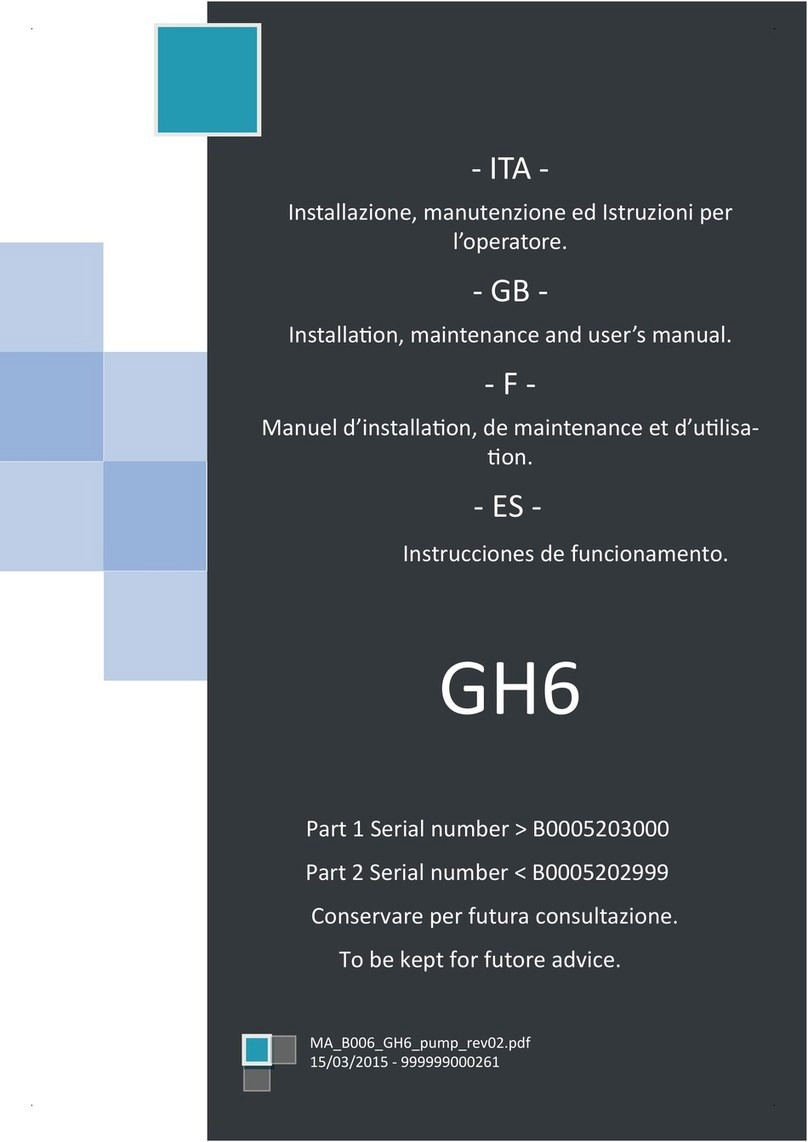
grandimpianti
grandimpianti GH6 Mounting instructions

grandimpianti
grandimpianti GH6 User manual
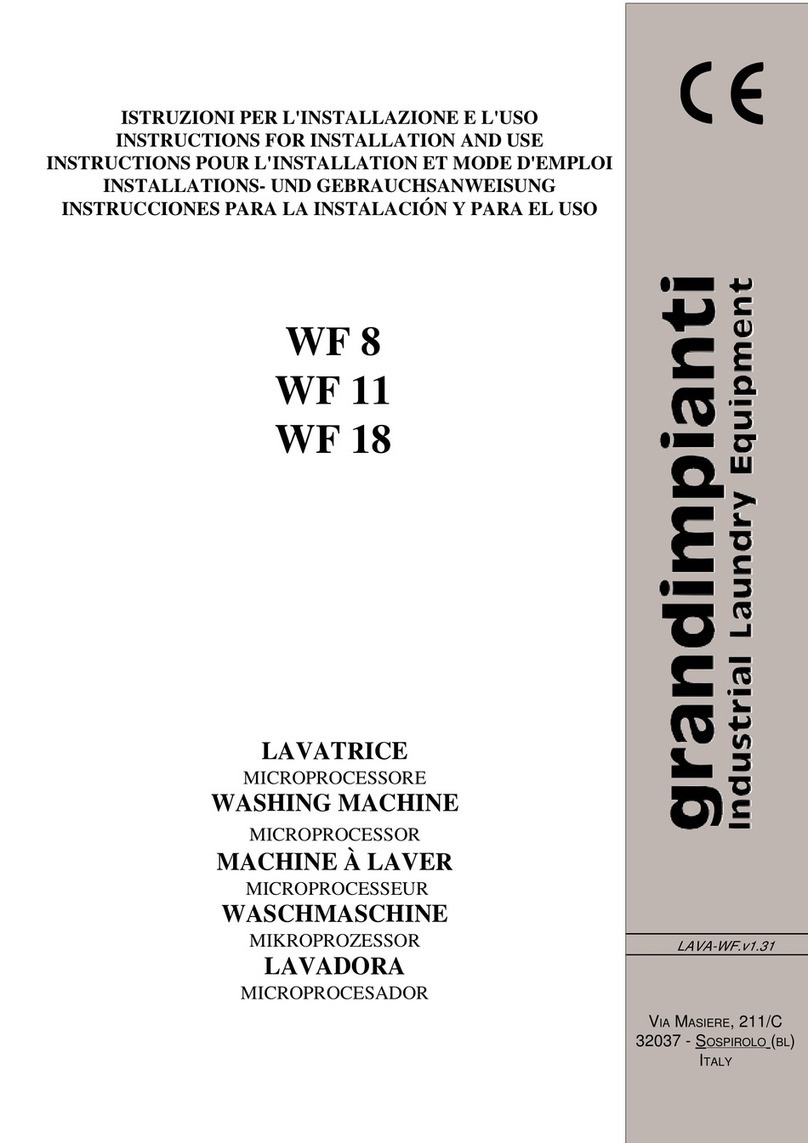
grandimpianti
grandimpianti WF 8 User manual
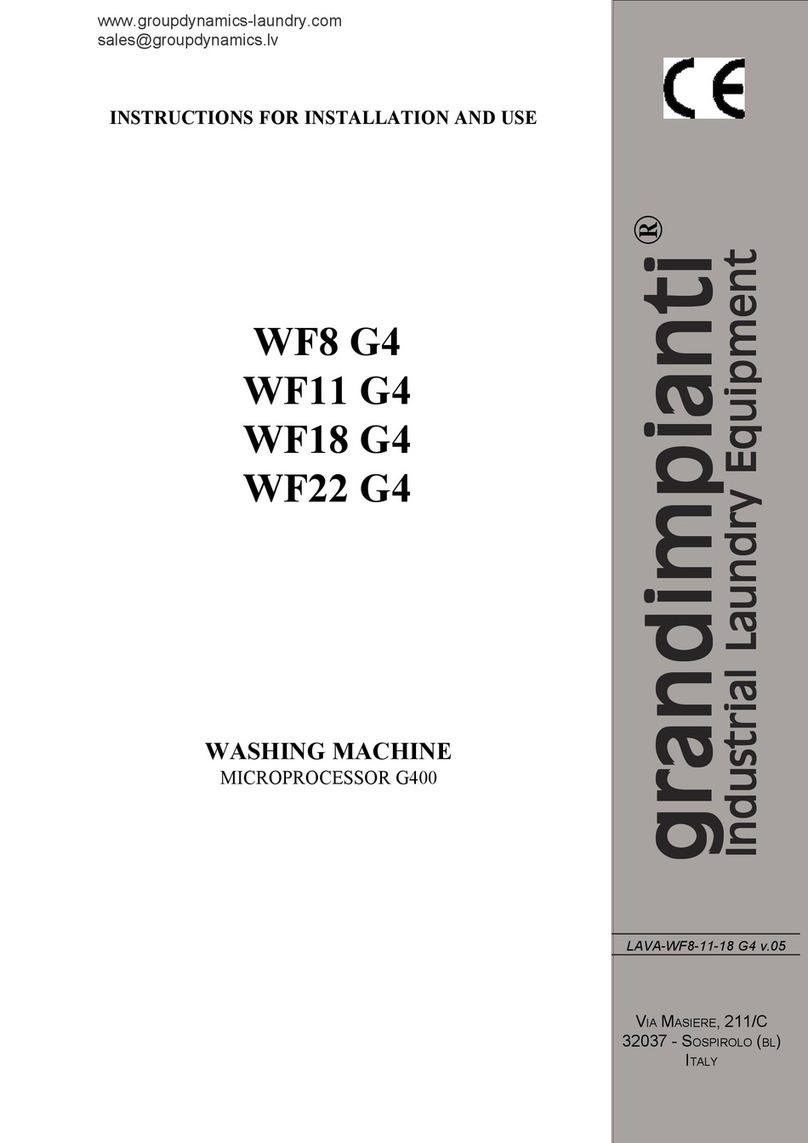
grandimpianti
grandimpianti WF8 G4 User manual
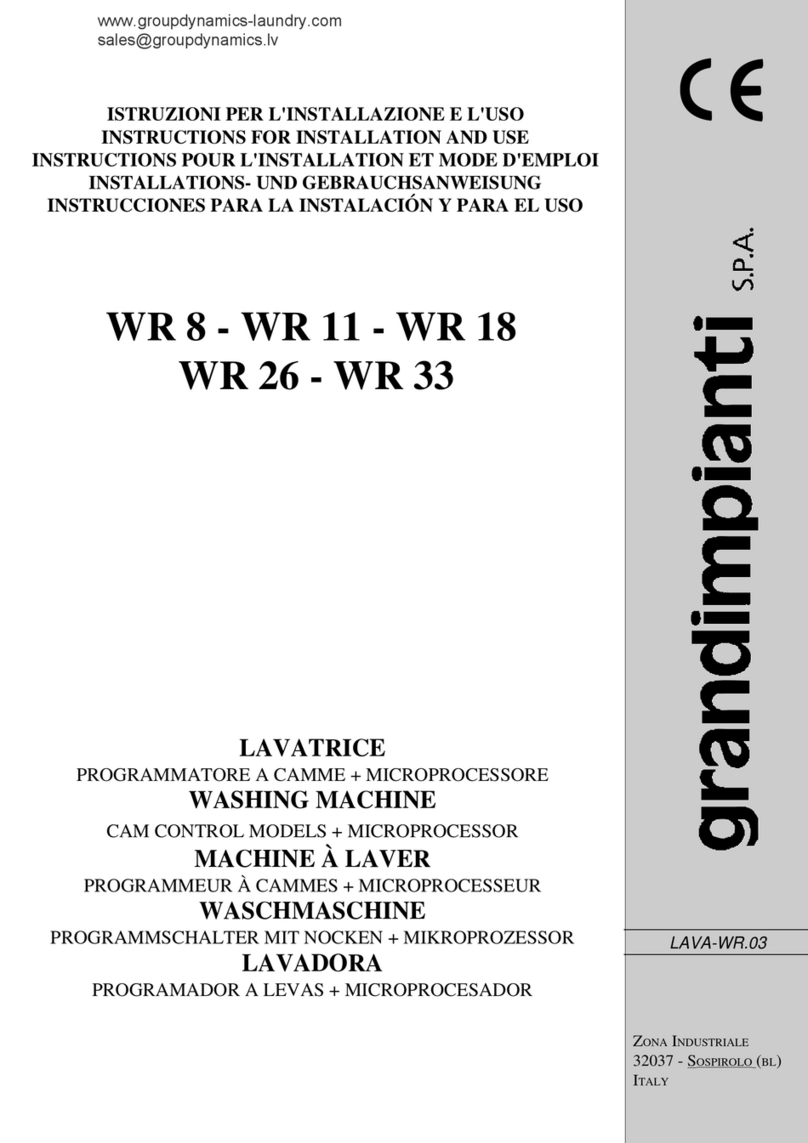
grandimpianti
grandimpianti WR 8 User manual

grandimpianti
grandimpianti WF6 User manual

grandimpianti
grandimpianti GH6V Mounting instructions

grandimpianti
grandimpianti WMC 81 User manual
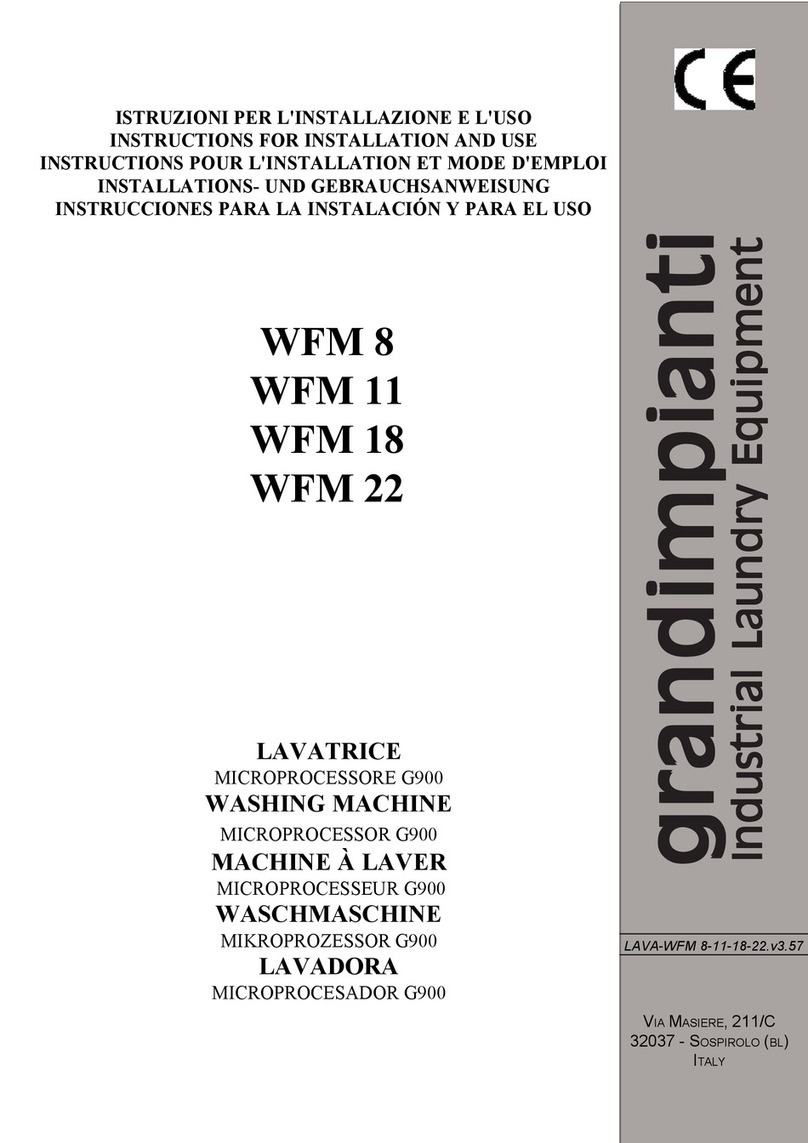
grandimpianti
grandimpianti WFM 8 User manual

